#rko auditions
Note
marina ida (splatoon series)

Can Marina Ida perform a…

#rko auditions#marina ida#ida marina#marina splatoon#Marina ida splatoon#splatoon marina#splatoon 2#splatoon 3#splatoon polls#splatoon posting#Marina#Ida#submitted by anonymous#character polls#fandom polls#poll time#polls#tumblr polls#poll blog#wrestling polls#poll game#hyper specific poll#wrestling#off the hook#octo expansion#side order#splatoon side order#splatoon
58 notes
·
View notes
Text
fanboy | m. verstappen
pairing: max verstappen x actress!reader
word count: 4.8k words
request: yes, by anons: "bestie hear me out, in a f1 video, i think it was this or that or smth like that, max said he has always loved spiderman. okay. so. imagine. reader is an actress right. she obvi cannot play spiderman. but. she gets the role of spidergwen. can you imagine? max finding out and he just reps his girl so much. he just has to let everyone know. everywhere he goes. that his girlfriend is fcking spidergwen. this got so long im sorry. ily and your work” & “hi bestie! hope you’re doing good :) i love your fics! could you potentially write an actress x max fic where they’re in a long distance relationship and it’s starting to effect them but in the end everything turns out great? 🥰” & “hello, can you write something with max verstappen where he and his girlfriend are expecting a baby girl. thank you”
warnings: mentions of j*s, h*rner and m*rko, mentions of silvestone 2021, language, pregnancy, i tried to write angst, but it didn’t work lmao.
a/n: sooooo i don’t know how to feel about this one. i feel like it’s missing something, but idk yet. also, this might be a bit too similar to ‘superheroes and flat caps’ but i just fell in love with that concept and wanted to write more like that one.
my masterlist

(look at this precious boyyyyy)
being cast in a marvel movie meant commitment, whether it was traveling to the other side of the world and living there for months on end, or staying late when it was necessary.
at first, you were extremely excited to become a part of this universe of compelling characters and devoted fans. you didn’t know exactly which character you’d auditioned for, but when your agent called you about a role in a new spiderman movie, and that marvel wanted you to audition, you knew you were going to do what was necessary to get that role.
max was the first person you told about this audition. he knew how long you’d been wanting to be part of a big movie franchise, through most of your career you’d only done stand-alone movies, this opportunity gave you the chance to grow as an actress, to explore a character in ways that you hadn’t been able to just yet.
you had been on your morning run when you got the call, jogging the streets of the small country you called home was your favorite way to start the day when the weather was nice. maybe not the running part, but you did like the view. you always invited max to join you, but he always claimed that if he were to run with you, he would just fall behind, too distracted by your presence. you’d shake your head and laugh.
“the view, max! do it for the view,” you said, grabbing his shoulders and moving him until he was standing in front of the stone edge, the water in the distance. but he moved his head, meeting your eyes as he smiled softly, then, without hesitation, he said;
“you’re the greatest view i could ever ask for,” your breath got caught in your throat, max turned so he was facing you, and gently kissed your cheek.
you smiled as you thought back to that day. the thought that max was waiting for you back home was what kept you going through the hard days. and that day, after the first rush of excitement had died down a bit, making way for nervousness and self doubt, you needed him. you knew it was just an audition, and that it was weeks away, but this was a really big opportunity for you and your career. you knew more chances would come, but you just had a feeling that this role in particular, even though you didn’t even know what character it was, was made for you.
you arrived home, feeling a weird sensation in your stomach, as if you were going to throw up. as you opened the front door you were met with the sound of music coming from the speakers.
“max?” you called, heading to the balcony, you knew he enjoyed working out there, and the already opened door was a big clue. “hey,” you said, he was lying on his back, he dropped the weight he was lifting to the side, rising up to his feet and greeted you with a kiss.
“how was your run?” he asked, holding your hand and leading you inside.
“good,” you replied, rushing the word out. you walked to the kitchen, sitting on a stool as max grabbed a cold water bottle from the fridge.
“everything okay?” he asked, you cursed yourself silently. for someone who had spent most of her life acting, you were not good at keeping your cool when lying.
“yup,” you popped the ‘p’, and max turned around and narrowed his eyes at you, you sighed, placing your crossed arms over the counter and hiding your face in them. “okay, no. i got a call and i’m nervous,” your voice came out muffled, and max frowned, sitting next to you. he placed a hand on your back.
“what? i couldn’t hear you,” his hand was warm against your back, you turned your head to look at him, he leaned down so he was imitating your posture. “hey, what’s wrong?” he looked concerned, and you chastised yourself mentally for worrying him about something so trivial.
“i got a call, from stephanie,” you started, max nodded, “i have an audition in three weeks, for a new marvel movie. a spiderman movie,” you said, realizing that spiderman was one of max’s favorite characters, that just added to the mix of nerves and anxiety you felt at that moment.
“that’s amazing!” he said, a smile forming on his lips. you straightened your back, nodding. “but?” he lifted his eyebrows.
"it's marvel!" you lifted your arms for emphasis. “and it’s a spiderman film, and you love spiderman, and-”
“and you’re you,” he leaned in, “you’re nervous,” he guessed.
“oh, i’m terrified,” you admitted, leaning your head on his shoulder. “i’ve been wanting to be part of anything marvel for so long now… and now that i finally have an audition with them…” you lifted your head, turning so you were face to face with max, “i can’t screw this up,” you shook your head.
“and you won’t,” he assured you, placing his hands on your arms. “you’ve gotten every role you’ve auditioned for, you’ve been offered roles without even having to audition,” he started, you looked up at him, “this won’t be any different, okay? they are interested in you for a reason. they know this role is for you,”
“but i… i don’t even know what role it is, and-”
“you won’t find out unless you try. and you know, i could help you rehearse your lines,” he poked your stomach, making you laugh, “i’ll be with you every step of the way.”
“thank you, max.”
“of course, schatje,” he said, leaning in and placing a kiss on your lips. “besides, what if you get to play spider-woman, or something like that?” you chuckled, kissing his cheek.
“maybe,”
-
max had been right, after all. after three rounds of callbacks and chemistry reads, you had been offered the role to play spider gwen for the live action ‘spiderverse’ film. after explaining to max the story of the character, he quickly declared it as his favorite character and superhero. you told him to keep it a secret, you couldn’t risk anyone finding out about this before marvel announced it or started teasing about it. he promised you his lips were sealed.
except that cheeky motherfucker, for once in his life, didn’t wear a red bull polo as he arrived to the track for his next race, he wore a marvel shirt.
you were in atlanta at that moment, on the first days of shooting the film, and had called him as soon as you were both available.
“hi, schatje,” he said, he eyes were crinkled at the corners, the little shit knew exactly what he was doing, knew exactly why you’d called him.
“hello, emilian,” you called him by his middle name, narrowing your eyes at him through the screen. “that was an interesting outfit you wore today,” you said, slowly raising an eyebrow.
“really? he asked, shrugging his shoulders, “i wore what i always do, jeans and a shirt,”
“oh, yeah, i’m well aware of your required uniform for the weekends,” you teased, “was surprised to see you not wearing a red bull shirt, though,”
“what can i say? i’ve been watching the movies and am becoming a fan,”
“max,” you chuckled, shaking your head slightly.
“did i get you in trouble?” he asked.
“no, don’t worry about that,”
“okay, good,” he nodded.
“but you can’t do it again. it already raised so many eyebrows, people will start talking, and speculating. i can’t risk anything leaking out, okay?”
“okay. i’m sorry. i just thought you… you know. you’re finally in a marvel movie, after working your ass off for so long, and i’m so unbelievably proud of you, i want to show you off,”
“and i love you and thank you for that, but… let’s wait until the movie comes out… or the confirmation of my role, at least, okay?”
“okay. i’m sorry if i caused you any troubles,”
“no, no, it’s all good, i promise. it’s just me, i- i can’t risk losing this,”
“and you won’t, i promise. i will lay low until you give me the thumbs up,”
“what does that mean?” you asked, smiling as you leaned back.
“i’ve already ordered a bunch of spider gwen shirts and caps, and sweatshirts,” he said, your eyes widened as you let out a small laugh.
“max!”
“my favorite girl is playing my favorite superhero, i’d be stupid if i didn’t show my support for you in any way i can, no matter how small,”
“i really want to hug you right now,” you said, sighing. this was the first time you’d be away for so long, almost two months without seeing each other in person.
“i wish i could, too.”
-
you never thought you’d struggle with long distance, for the almost two years you and max had been together, you were always in sync, you always knew what the other needed without having to ask.
maybe it was the distance, or the timing, maybe it was just a small bump in the road for the two of you.
as you moved overseas for a few months to film, you tried to watch and follow the races as much as you could, but your hectic schedule made it impossible sometimes, and you had to settle for watching the replays when you had the time, or just watching the highlights.
one day in july, you were just about to wrap filming, and had been asked to start really early, and to stay extremely late. you were up before the sun, texting a quick ‘good morning, good luck. i love you.’ to max before leaving your phone in your trailer and focusing on, what you were hoping would be, your last day of filming.
things had been a little tense between max and you, you missed him terribly, and so did he. you both tried to make time in your schedules to facetime for at least five minutes, but the time difference, plus the million things you had to do, plus the fatigue and tiredness made it almost impossible. you relied on texts, a good morning and good night text was the one thing you never missed.
the day had started out just like any other, you were aware that the race was an important one, from the bits and pieces of information you read online and had spoken to max about, silverstone would be a decisive race for the championship title. and it broke your heart that you wouldn’t be able to watch it, but you wanted to finish as soon as possible so you could get back to your designated spot in max’s garage quickly. you’d already missed so much.
max knew that you had your own career to focus on, during all the time you’d been together, he was aware that you weren’t going to be there for him all the time. he knew that. but you’d never been apart for so long. he knew his life wouldn���t be over if he didn’t win the championship that year, but the people around him counted on him, they, and max himself, were putting too much pressure on him, he was about to snap.
silverstone was not supposed to turned out the way it did. he wasn’t supposed to crash into a wall at 51gs, he wasn’t supposed to be taken to a hospital to make sure he was all right. he wasn’t supposed to be told that you didn’t pick up the calls because you didn’t care about him.
seeing the over fifty missed calls made your heart start racing. it was almost 2am in atlanta, which meant it was a decent time on the other side of the world. you dialed max’s number and put it on speaker, reading the texts you’d received as you waited for him to pick up.
you had texts from friends asking how max was, how you were, but you didn’t understand why. you kept scrolling as you heard the monotone beeping. your heart raced inside your chest as you heard the voice telling you you’d reached his voicemail, you dialed again, waiting as you felt tears in your eyes whilst you read about the crash.
“(y/n)?” you let out a deep breath in relief as you heard his voice.
“max!” you sighed, the tension in your shoulders easing, “max, i’m so sorry, i just read about the crash. i was busy all day. how are you? are you okay? i’m so sorry i couldn’t be there, i promise i’ll jump in a plane and-”
“i’m okay,” he cut off your rambling.
“is.. are you out of the hospital? what did they say?” you asked, running a hand through your hair.
“i’m okay,” he repeated.
“what’s wrong?” you asked, frowning. the tone in his voice was enough clue, he wasn’t okay. he didn’t reply, but you could hear his breathing on the other side of the line. “max, what’s wrong?”
“why weren’t you answering?” he asked, his voice took you by surprise, he sounded angry.
“wh-what? max, i- i was busy on set all day. we just finished the film.”
“and you didn’t even get a five-minute break?”
“i don’t- what are you trying to say?” you asked, you didn’t know where this was coming from.
“forget it,” he said, you shook your head even though he couldn’t see you.
“no. no, what do you mean by that? max, i am doing my job here, if i could’ve been there with you, i would’ve. i want to be with you, i stayed awake for almost twenty four hours so i could finish filming and get back to you.”
you were met by silence on the other end of the line, you sighed as you dropped on your couch.
“there were pictures, the other day,” he started, you remained quiet, “of you and…”
“oh my god,” you said, exasperated, “i went out to dinner with my cast mate,”
“i know. i know that. but they-”
“they?” you asked, already knowing where this was going.
since the beginning of your relationship, you hadn’t been that well received by the red bull team principal and advisor, or by max's own father, they thought you were a distraction for their beloved driver. they knew they had a future world champion in their hands, and they sometimes forgot that he was a human, with feelings and desires and wants and needs, they wanted max to dedicate all his time to racing, not a girl.
“when are you coming home?” his voice was small, you could hear the regret in his words, could practically see him crestfallen, lying on a hotel bed all alone.
“i’ll book the earliest flight to london. i can get someone to send over all my stuff.” you sighed, knowing this conversation was not finished. “are you okay, max?” you asked, now that you knew what was really troubling him, you knew he could be honest.
“i just need you,”
“i’ll be there.”
“i’m sorry,”
“i know.”
-
with a cap on your head, sunglasses covering your eyes, you arrived at max’s hotel. you skipped the front desk, going straight to the elevator and hitting the button for floor number nine. you stepped out and walked to the right door, knocking twice, once, and twice again. seconds later, you saw max’s face, in front of you, for the first time in months.
you forgot about literally everything else at that moment, every single thing that worried you was thrown out the window the moment you felt his hands on your waist, you threw your arms around his neck and pulled him down, closer to you until you had your face buried in the crook of his neck, you inhaled deeply, having missed his scent. you’d missed everything about him.
“i missed you so much,” you heard him, felt him pushing you closer to his front. you let him drag you inside the room, he turned you both so he had his back against the door, he pushed it and closed it, leaning against it for support. “i love you. i’m sorry.”
“i know. i know, i love you too.” you whispered, leaning back so you could look at him. even in the dim lights of the room, you could see a faint bruise on the side of his cheek. instinctively, you lifted your hand to touch it, your fingers met his skin gently, they tingled at the contact.
“now i- i think it’s better that you didn’t see the crash,”
“why?” you asked, stroking his cheek softly.
“you would’ve been so worried. i don’t like that you worry so much about me,”
“i have to.” you answered, shrugging your shoulder, “i’m so sorry i couldn’t be here,”
“no. no, don’t apologize.” he shook his head, you dropped your hand down to his shoulder, “you were right, you can’t always be here, and i’m happy that you have things to do, i’m happy that you have a job that you love, just like i do. i don’t want to take that from you, i don’t want you to stop doing what you love just because of me.”
“i would if you asked me,” you blurted out, you didn’t think it twice, they just came out.
“and i would, too, but the point is that i was out of line. i know how hard you’ve worked for your career, and i can’t take that away from you, i can’t be mad because i know how much you’ve done for me.”
“let’s just… forget about it, okay? i know that you are under a lot of pressure right now, and the worst thing is that it’s not coming from yourself. but you can’t let their words get to you, max. it’s not healthy, it’s not okay. they have no right to do this to you. you will have many more opportunities to win a championship, you know that.”
“i know,” he turns his head to the side, you saw a new bruise on the other side of his face. you leaned forward, your lips meeting the light purple mark on his face.
“i’m sorry i couldn’t be there for you.”
“ no, no, don’t apologize. you’re here now, and that’s all that matters. that’s all i need.”
from that moment onwards, you never left max’s side on race weekends. all the side eyes you received from people that didn’t want you there were met by a tug on your hand from max, pulling you closer to him. you were happy again, nothing could ever ruin it.
-
having a child was something you’d never discussed. of course, you pictured a future with max, you loved him deeply and he loved you just the same. but you both were too focused on your careers, you were in your prime. young, talented, focused, hardworking.
a child wasn’t in your plans, at least, not at that moment. you’d tried to convince yourself that missing your period was just because you were overworking yourself. the tests could be wrong, there was a chance that you had a false positive.
that’s what you told yourself to calm yourself down. you couldn’t freak out, but you couldn’t be pregnant.
it was not hard to guess when you could’ve gotten pregnant, from the moment you finished shooting you and max had not wasted a second in making up for the lost time. you were both insatiable, craving the other’s touch, the delirious rush you got when he touched you.
you heard a knock on the door, you swallowed a lump in your throat as you looked up.
“come in,” you said. there was no point in hiding it.
“hey, everything okay? you’ve been here a while,” max said, entering the bathroom and closing the door with his back, leaning his weight against it.
“yeah, i… um, here,” you extended your arm, handing him the test. it took him a few seconds to take it.
“huh,” he said, walking next to you, he sat down and pressed his shoulder against yours.
“what now?” you asked, leaning your head on your shoulder, looking to the wall in front of you.
“i don’t know,” max said, his hand held yours, you laced your fingers through his, holding tightly. “but i’m with you every step of the way, okay?”
“okay,” you answered.
-
after a lot of talk between you two, you agreed to keep the baby. maybe you weren’t ready yet, and you had a million reasons to wait until the time was right, but you couldn’t deny that the thought of a little mini max running around the apartment was an endearing one. after the first shock and doctor appointments, you let your mind wander.
you found yourself rubbing your stomach whenever anything happened. whether it was happy, sad, scary, anything, your hand went there instinctively.
at first you’d managed to hide your stomach behind big sweaters, taking advantage of the cold weather. the pregnancy didn’t stop you from going with max to the races, you loved the quiet moments you got before he had to leave for each session, where you would lay on his massage table, and he’d lift your shirt up, exposing your stomach, and pepper it with kisses all over. the baby bump was barely there, barely noticeable, but the fact that you two knew there was a mini you or mini max in there was enough to drive him crazy. he’d talk to your future kid, explain everything he was about to do in the car, ask him or her to not give you much trouble or make you sick.
your first reaction to the news might not have been the best, but everything changed the moment you started planning ahead, when you started looking at baby clothes and started buying furniture and decoration for the baby’s room, there was no going back from there. max was already in love with the little being that would one day become his son or daughter.
the day he won the championship was one that you’d never forget, it was also the day he almost let it slip that you were pregnant. as soon as he jumped out of his car and made his way to you, he wrapped his arms around you and kissed you, his hands involuntarily going over your stomach. you grabbed them in yours, and placed them on your waist again, hoping the action wasn’t noticed by many people.
the pregnancy slip-up became a revelation just a few days later. you were invited to the premiere of the new spider-man movie, and since no one other than the cast knew about your involvement in the project, plus your very known love for marvel movies, no one raised an eyebrow when they noticed your presence there. you received looks, though, when you posed on your side for pictures. the dress you wore accentuated your bump, made it obvious to anyone who looked your way.
the dress, plus max’s protective arm around your back, his hand over your stomach, that was a clear giveaway for anyone who looked your way.
after the movie premiere, came the fia prize giving gala. you’d dodged a bullet in the premiere, you hadn’t been asked to do any press, but now that all eyes were on max, you couldn’t escape the questions.
as always, he was very private about his personal life, but even with his usual serious and pulled back demeanor, he couldn’t stop gushing about you or the baby. you were approached by many people, congratulating both you and max for all your accomplishments, plus for your new role as parents. when it was time for him to step onto the stage to collect his trophy, you struggled to hold back tears.
“thank you to the fia, to the team, they’re the ones who made this possible. thank you to my family, and friends, for always having my back. thank you to my girlfriend, (y/n), this year was a really hard one for the two of us, but the thought that no matter how my day went, i’d go home and find you waiting for me with a smile on your face, that helped me more than you could ever imagine. to my future son or daughter, this is for you.”
-
the race in italy was one that you were waiting for. you hadn’t been able to join max for any previous races because, now that your role in ‘spiderman: no way home’ was public knowledge, you were now caught up in interviews and talks about possible future projects. you were almost about to pop, so you had to take advantage of all the free moments you had so you could travel with max wherever he went.
you were in your hotel room, really early on a friday morning, doing an interview through zoom.
“this past year was a pretty busy one for you, wasn’t it?” the interviewer asked, you smiled, nodding, “filmed a secret movie, you’re expecting a baby, your partner won a world championship,” she listed, your grin only grew as she continued, “what else can we expect from you this year?”
“well… i don’t know yet. i think i’ll take a little break while i get adjusted to this new role, probably the most challenging role i’ll ever have in my life,” you chuckled, tucking a strand of hair behind your ear, “but after that… who knows? i’m open for anything that life has in store for me,” you smiled.
“do you like my shirt?” you heard from your left. you glanced at max for one second, you’d told him you were doing an interview, he knew that.
“sorry, one second,” you turned off your microphone as you looked at him, “baby, i’m busy,”
“you didn’t answer,” he almost pouted, you could see him push his bottom lip out.
“love it,”
“is everything okay there, (y/n)? we can pause or-”
“no, i’m sorry, it’s just… got a little distracted,” you looked back to your screen, “sorry about that,”
“hello!” max said, running until he was standing next to you, leaning down so his face was next to yours, taking up half the space on the interviewer’s screen.
“um, hi! this is a nice surprise,” she chuckled, you put your arms on the desk and hid your face in them.
“i am dating a child, as you can see,” you laughed.
“here, look at my shirt! it’s her!” max stood up, he was wearing one of the many shirts he’d bought when he found out you got the role. the t-shirt had a drawing of the character in her superhero outfit.
“that’s a lovely shirt! you two are a lovely couple, i’m sure you’ve heard that one before, but it’s true,” you smiled at her words, as max ran to the bed and came back with more shirts.
“i have more. i bought all of these when i found out she was playing spider-gwen. i’ve always loved spider-man, and i didn’t really know this character existed until a few years ago. she’s perfect for the role, isn’t she?” he rambled on, you just shook your head in disbelief as your cheeks started hurting.
“she is, played it perfectly,” the interviewer laughed, “well i’ll let you both go. it was lovely talking to you, good luck on your race, your movies, the baby, well… everything.” she laughed, you both smiled, you felt max's hand on your shoulder.
“thank you so much! have a nice day,” you said goodbye as max waved his hand from behind you. you exited the video conference, closing your laptop and slowly turning your torso around. you didn’t say anything, just stared through narrowed eyes at max’s shit-eating grin.
“you’re not dating me,” he pointed out.
“what?”
“you’re engaged to me, that’s different.” he helped you stand up, then took your engagement ring off from his pinky, sliding it back into your left hand.
"fine then, i am engaged to a child," you poked his stomach with a finger, laughing as he doubled over.
"that would be weird," he said, you laughed, running your fingers through his hair. "is she awake?" he asked, sliding his hand over your stomach.
it was like your daughter knew when her father wanted to talk to her. like she knew it was him just from the weight of his hand over your belly.
"she is now," you looked down at your stomach, feeling as she started moving inside of you, "oof," you tugged lightly on max's hair when she kicked you close to your ribs, "not cool, baby," you tapped your stomach twice.
"let's be nice to mom, okay? i'm the one that has to deal with her when you make her mad," he leaned down and placed a kiss on your bump. you huffed, slapping his head lightly, earning a chuckle from him. "or keep doing it, she looks hot when she's mad,"
"max," you warned.
"it's the truth!"
#max verstappen imagine#max verstappen fan fiction#max verstappen one shot#max verstappen fanfic#max verstappen blurb#max verstappen x reader#max verstappen fluff#max verstappen oneshot#max verstappen angst#max verstappen fic#max verstappen x you#max verstappen x actress!reader#f1 imagine#f1 one shot#f1 x reader#f1 fic#f1 fanfic#f1 fandom#f1 fanfiction#f1 drivers#f1#f1 drivers one shot#f1 drivers x reader#f1 drabble
1K notes
·
View notes
Text
TOUR DE LUCY!
Lucy & Cycling

Pedal Power! When not motorized or on foot power, Lucy biked! Here’s a look at bikes, trikes, and other likes.

Ben Mankiewicz’s podcast relates that Lucille Ball, as a young Hollywood hopeful, biked to work.

Broadway Thru a Keyhole (1933) ~ A bevy of costumed chorines - including an uncredited Lucille Ball, Susan Fleming and Ann Sothern - wheel around a giant nightclub stage to the tune of “When You Were a Girl on a Scooter (And I Was the Boy on the Bike)”. This was Lucille Ball’s second film. It also featured Charles Lane and Walter Winchell.

Palm Springs Weekend (1942) ~ An RKO short in which newlyweds Lucy and Desi rent a tandem bike to tour Palm Canyon, stopping to take snapshots.
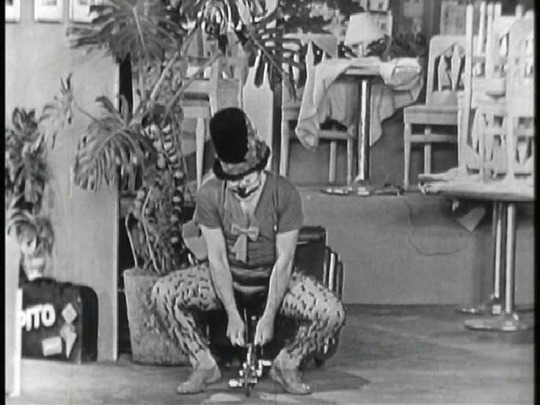
“The Lost Pilot” (1951) ~ Pepito the Clown (Pepito Perez) was a good friend of Desi Arnaz. In the long-unaired pilot episode for “I Love Lucy” Pepito rides the world’s smallest bicycle, a routine that was part of his stage act.

“The Audition” (1951) ~ When the unaired pilot’s script was recycled into the regular series, Pepito was replaced by Buffo the Clown (Pat Moran) who injures himself trying to do a handstand on the handlebars of a (full-sized) bicycle. Resting at the Ricardo’s apartment, he tries the stunt again and careens through the kitchen door. His replacement is Lucy as ‘The Professor’, although she doesn’t ride the bike!

“Lucy’s Show-Biz Swan Song” (1952) ~ When the episode was running short, Desi Arnaz invited Pepito to do some of his act from the unaired pilot, including the world’s smallest bicycle routine.
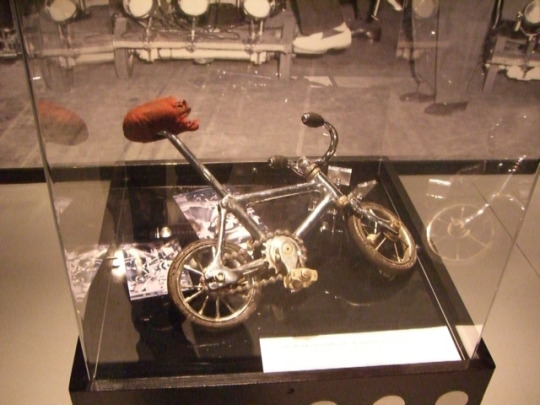
The tiny bike (one of two) is six inches wide by ten inches high, manufactured by Anderson, Melbourne, Australia, in 1928. It was at one time entered into Ripley’s Believe It or Not. Pepito was in Australia in 1928 for an extended vaudeville tour, and he must have ordered this bicycle at that time. It is now one of the artifacts in the Lucy-Desi Museum’s collection. A special case was been constructed to exhibit it.
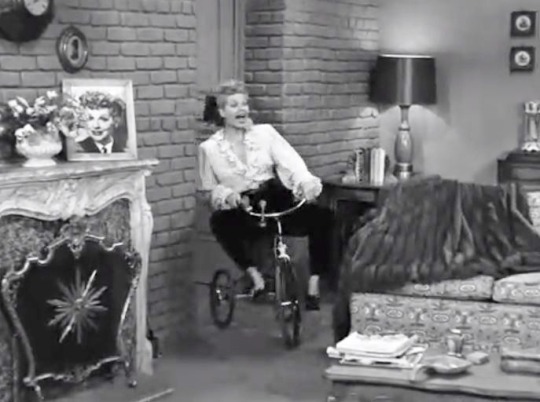
“Lucy Fakes Illness” (1953) ~ To convince Ricky she is going through her second childhood, Lucy rides a tricycle through the living room!
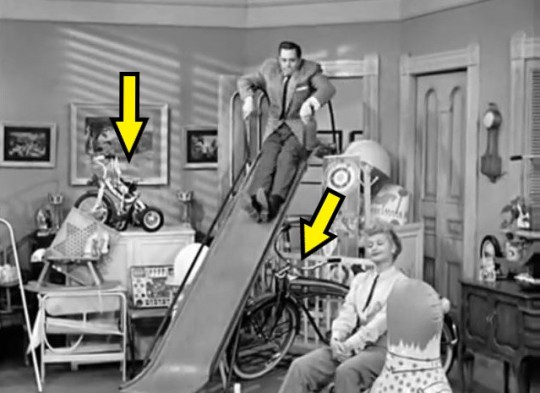
“The Ricardo’s Change Apartments” (1953) ~ Lucy fills the apartment to the brim with toys and baby items to convince Ricky they need a bigger apartment. Among the explosion of tot props is a tricycle and a bicycle!
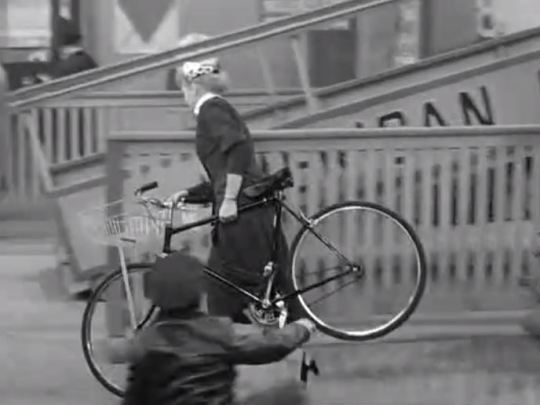
“Bon Voyage” (1956) ~ A bicycle is Lucy’s undoing when boarding the S.S. Constitution for Europe. Saying one last farewell to Little Ricky on the dock, her skirt gets caught in the chain of a messenger bike, delaying her timely boarding. She even tries to board with the bicycle!
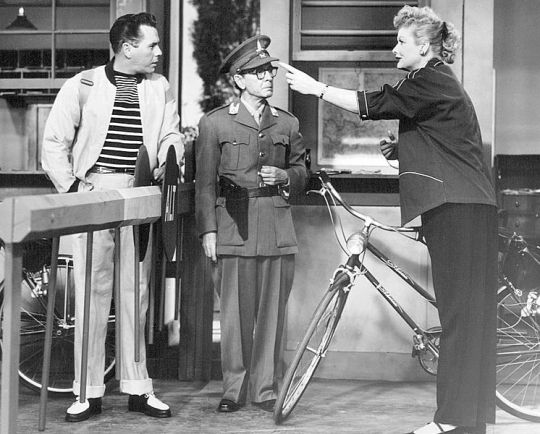
“Lucy’s Bicycle Trip” (1956) ~ When leaving Italy for France, Lucy has her heart set on biking across the border, but meets some resistance from Ricky and the Mertzes.
LUCY: “You wouldn’t climb to the top of the Eiffel Tower. You wouldn’t ride the ski lift in Switzerland. You won’t swim in the Mediterranean and now you don’t want to bicycle along the Italian Riviera.”
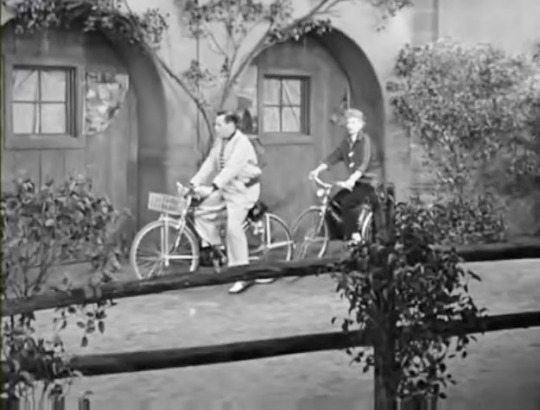
The bicycles used in the episode were provided by Arnold Schwinn and Company in return for a screen credit.

“The I Love Lucy Christmas Show” (1956) ~ Little Ricky gets a new bike for Christmas!

“Lucy is a Kangaroo for a Day” (1962) ~ To buy her son a new bicycle for his birthday, Lucy takes a job at a law office - until things ‘unravel’. Her knit dress becomes entangled in the spokes of the bicycle and unravels, causing her to have to wear a kangaroo costume to complete the job.

A carefree Jerry (Jimmy Garrett) rides his new bicycle through the living room!

A receipt from a Hollywood bicycle shop for the purchase of a bicycle basket and bike rack. Dated December 22, 1962, it was signed by Lucy. It is not known if the items turned up on screen or in what show / episode.
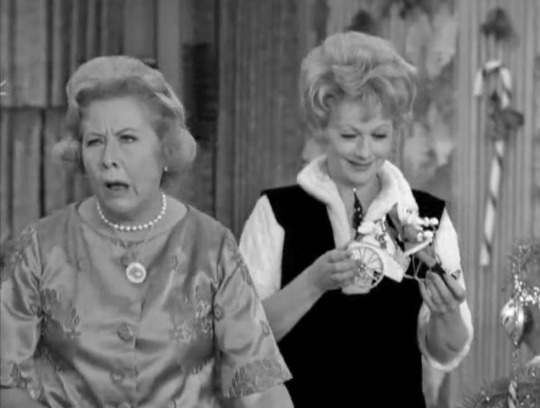
“Together for Christmas” (1962) ~ Combining their family holiday traditions, Lucy holds her favorite ornament, a Santa on a three-wheeled bike. Viv’s expression betrays her feelings about the ornament.

“Bob Hope’s Leading Ladies” (1966) ~ In the special, Lucy makes her grand entrance riding a large tricycle with her chauffeur (Jerry Colonna) on the back.

“Lucy in London” (1966) ~ Lucy and singer / songwriter Anthony Newley tour London town on a tandem bicycle.
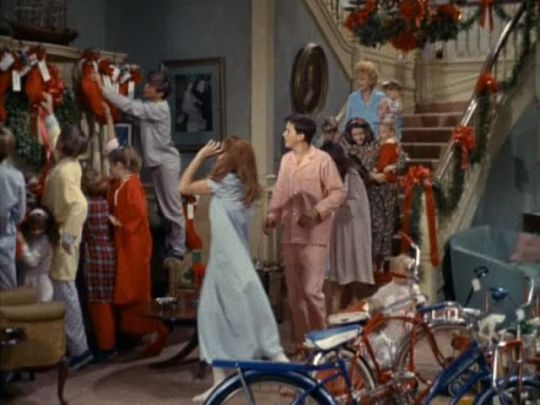
Yours, Mine and Ours (1968) ~ In the film, Helen (Lucille Ball) and Frank (Henry Fonda) are the parents of 19 kids! On Christmas morning, more than a couple of them get bicycles.

“Lucy Helps Craig Get a Drivers License” (1969) ~ Lucy tags along on Craig’s road test. Needless to say the back seat driver frustrates and angers the instructor (Jack Gilford). When he learns that her license has expired, he says that after he's through with her she'll be lucky to drive a tricycle in Griffith Park!
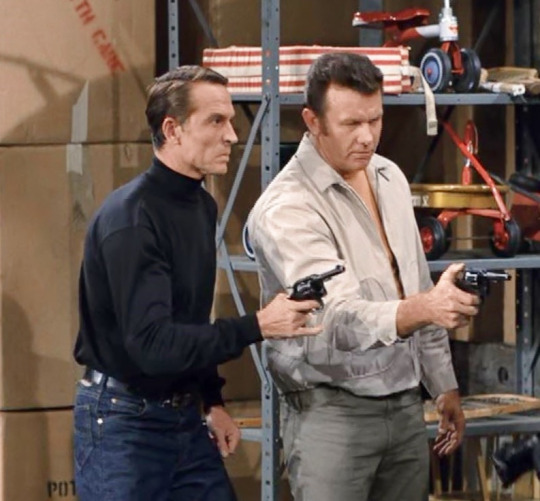
“Lucy and Wally Cox” (1970) ~ Wally and Lucy are security guards at a toy warehouse that is robbed at gunpoint. There is a tricycle on the shelf behind the robbers (Gil Perkins and X Brands).
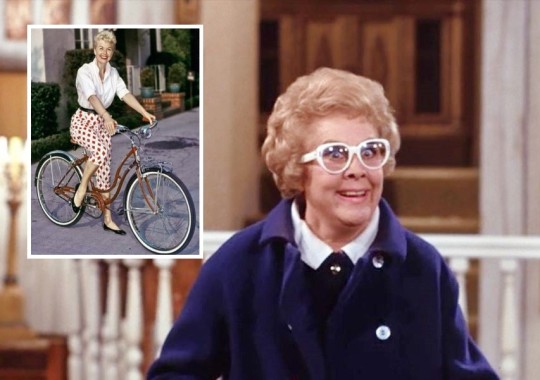
“Lucy and Lawrence Welk” (1970) ~ Lucy sends her visiting friend Viv on the Universal Studios tour, where she is excited to have seen Doris Day’s bicycle! All this is reported by Viv and neither Day nor her bicycle appear on screen. In real life, Doris Day was an avid bike rider. She rode to the studio on many occasions and pedaled around Beverly Hills until the police finally told her they couldn’t guarantee her safety.

Mame (1974) ~ Auntie Mame (Lucy) and her nephew Patrick (Kirby Furlong) bike through central park in the film adaptation of the Broadway musical.
EXERCISE BIKES
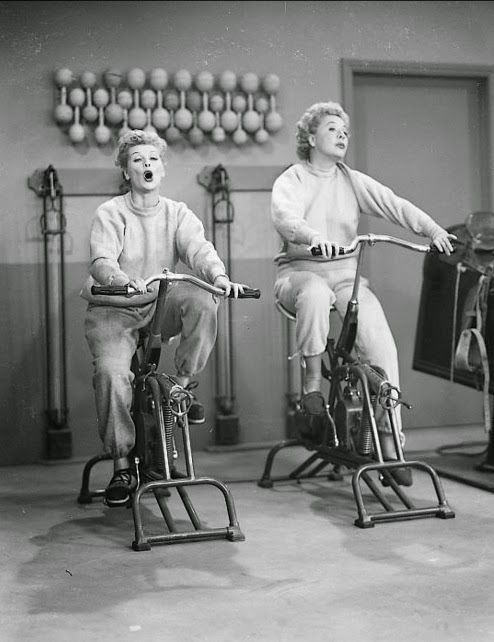
“The Charm School” (1954) ~ At Phoebe Emerson’s salon, Lucy and Ethel work out on stationary bikes. If you don’t remember this moment, it is because it was cut before broadcast. The press photos, however, survive.
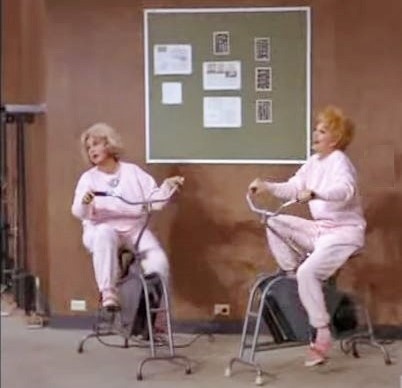
“Lucy and the Countess Lose Weight” (1965) ~ At a health farm managed by Mr. Mooney, Lucy and Rosie (Ann Sothern) pedal away the pounds!
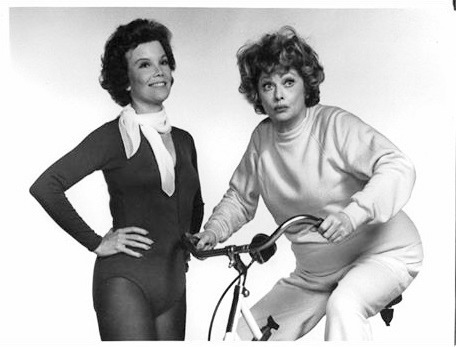
“Happy Anniversary and Goodbye” (1974) ~ Norma and Fay (Nanette Fabray) keep fit for their husbands in Ball’s first post-series TV special. Arnold Schwarzenegger plays a masseur.
SONG CYCLE
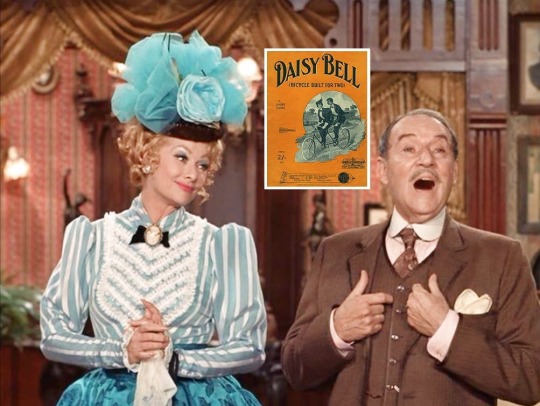
“Lucy and the Generation Gap” (1969) ~ Includes the song “Daisy Bell” aka “Bicycle Built for Two” written in 1892 by British songwriter Harry Dacre.
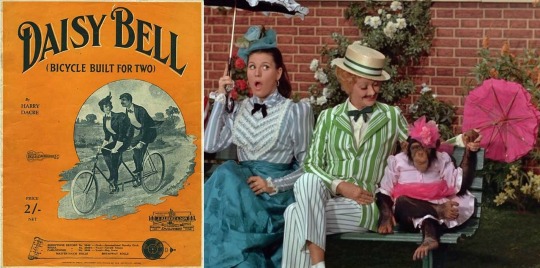
The song is heard again in “Lucy’s Lucky Day” (1971).
You’ll look sweet
Upon the seat
Of a bicycle built for two!
CALL ME MR. BIKE
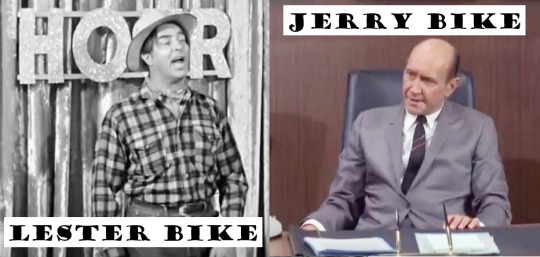
“Tennessee Ernie Hangs On” (1954) ~ featured Richard Reeves as Ernie’s old pal Lester Bike, host of “Milliken’s Chicken Mash Hour”. “Lucy Saves Milton Berle” (1964) ~ featured Milton Frome as Jerry Bike, Berle’s agent. The agent’s name is never spoken aloud, but is listed in the end credits.

A Lucille Ball impersonator takes a carefree trike ride at Disney Studios. [photo by Lori Mundy].
#Lucille Ball#Bicycles#Bike#Bikes#Tricycle#Tricycles#Tandem Bikes#Bicycle Built for Two#I Love Lucy#The Lucy Show#Here's Lucy#Vivian Vance#Desi Arnaz#Richard Reeves#Milton Frome#Gale Gordon#Lucie Arnaz#Nanette Fabray#Ann Sothern#Kirby Furlong#Mame#Doris Day#Anthony Newley#Bob Hope#Jerry Colonna#Jimmy Garrett#Pepito Perez#Broadway Thru a Keyhole
6 notes
·
View notes
Text
Dean Stockwell, Reluctant Child Star By Raquel Stecher
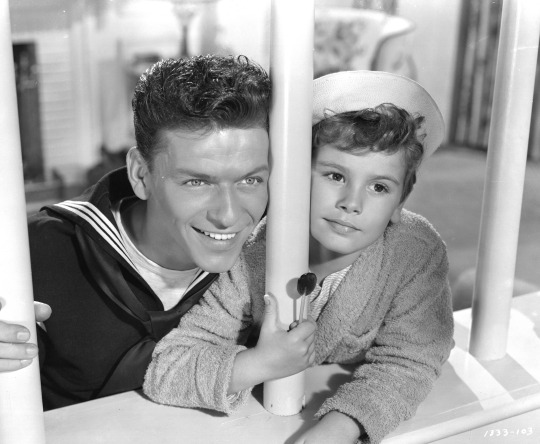
Born in Hollywood to a show business family, it seemed like Dean Stockwell was destined to become a movie star, but Stockwell stumbled into the industry simply by chance. In 1942, his mother Elizabeth “Betty” Stockwell, a vaudeville performer, and his father Harry, a stage singer best known for being the voice of the Prince in SNOW WHITE AND THE SEVEN DWARFS (’37), heard of a casting call for children. Dean and his older brother Guy auditioned for roles in a stage performance of The Innocent Voyage. Though only landing a small part with just two lines, it was all that was needed to catch the eye of an MGM talent scout. Before he knew it, the nine-year-old Stockwell had a seven-year contract with the studio. He was exactly what they were looking for. With his mop of curly hair and prominent pout, he gave off just the right combination of innocence and petulance that would make him a perfect fit to play orphans and spoiled rich kids in a variety of MGM productions.
Dean Stockwell was off to a roaring start with plum roles in big productions like ANCHOR’S AWEIGH (’45), THE GREEN YEARS (’46), GENTLEMAN’S AGREEMENT (’47) and SONG OF THE THIN MAN (’47). He held his own with big stars like Gregory Peck, Gene Kelly, William Powell, Myrna Loy, Greer Garson, Robert Ryan and Lionel Barrymore and other child stars Peggy Ann Garner, Darryl Hickman and Margaret O’Brien.
He was an incredible asset to MGM. Stockwell could be counted on to cry in front of the camera, sometimes coaxed by a director who encouraged him to imagine a dying pet. Even with that, Stockwell developed a reputation as an intelligent and sensitive young boy who needed little rehearsal and minimal direction. They called him “One-Take Stockwell.” In interviews years later, he recalled “I had photographic memory when I was a kid. I still can memorize lines very easily.” Stockwell was a natural and the parts just kept coming. When he wasn’t working for MGM on films, his home studio would loan him out to RKO, 20th Century-Fox and Universal.

But Being a child actor took a toll on Stockwell. The studio system could be cruel to child stars and Stockwell often bore the brunt of it. In an interview Stockwell said, “[as a] child star… I didn't have much privacy and I was working all the time. I couldn't be where I wanted to be; I couldn't play; so I needed to find anonymity, to just disappear.” He often worked 10-hour days six days a week, which included 3 hours of learning in the Little Red Schoolhouse on the MGM lot. He had to keep going for two reasons: 1.) his ironclad contract with MGM and 2.) a family to support, now that Betty was raising Dean and his brother as a single mom. Stockwell desperately wanted to be an average kid. He loved playing sports, dreamed of going to public school and loved spending time with his dogs, Thug and Thief. On the set of STARS IN MY CROWN (’50), he even declared to producer William Wright “I wish you’d fire me, so I wouldn’t have to work!”
During his seven-year contract with MGM, he made nearly 20 films for his home studio and others while on loan out. For the most part, Stockwell was miserable working as a child actor but there were two productions that he particularly loved. One was the anti-war drama THE BOY WITH THE GREEN HAIR (‘48) produced by RKO. In it, he plays a war orphan whose hair suddenly turns green, making him stand out from the locals. Stockwell identified with his character’s desire to fit in and the film’s pacifist message. When Howard Hughes tried to get him to deliver a pro-war statement, Stockwell stood up to the studio tycoon and refused. A few years later, he starred alongside Errol Flynn in KIM (’51), an adaptation of Rudyard Kipling’s classic story. Flynn became a father figure of sorts to young Stockwell and the two got on like a house on fire.
As Dean got older, he entered into what he called the “awkward age.” He later said, “[MGM] couldn't see how they were going to cast me now that I was turning 17. So they let me out of it and I just took off.” Dean finished high school, attended UC Berkeley and dropped out before finishing his first year. He didn’t know what he wanted but he did know he no longer wanted to be Dean Stockwell the child star. He donned a new identity, Rudy Stocker, and lived in anonymity as a day laborer. He made his way back to acting after a few years. Had it not been for his escape from Hollywood, a time period Stockwell referred to as “an education in living”, as well as the support of his mother, he might have gone down the wrong path as other child actors have done. Instead Dean Stockwell made an excellent comeback in the Leopold and Lobb inspired murder drama COMPULSION (’59). Reflecting on his past, Stockwell said “I have to know if people want me – for myself.” He would make several comebacks throughout his acting career and he learned an important lesson from his days as a child actor: be true to yourself.
youtube
#Dean Stockwell#child stars#actors#old Hollywood#studio system#MGM#acting#TCM#Turner Classic Movies#Raquel Stecher
136 notes
·
View notes
Photo
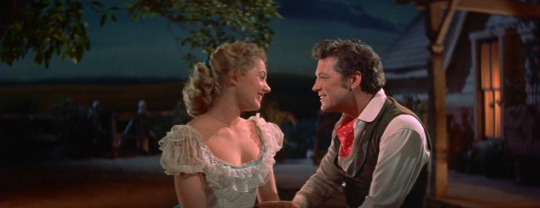
Oklahoma! (1955)
Composer Richard Rodgers was in search of a new songwriting partner in the early 1940s. His previous partner, the lyricist Lorenz Hart, was devolving into an alcoholism that would soon claim his life. Wanting to transform Lynn Riggs’ rustic play Green Grow the Lilacs into a musical, Rodgers would find a new lyricist in Oscar Hammerstein II, who had not been involved in any Broadway successes for some time. Rodgers and Hammerstein’s 1943 adaptation of Rigg’s play was Oklahoma! and – despite widespread predictions that Broadway audiences would only flock to modern, urbane works – it became the longest-running Broadway musical for another dozen or so years. It began one of the most fruitful, important, and accomplished musical theater partnerships in the medium’s history.
Interest in a cinematic treatment from Hollywood’s major studios for the first Rodgers and Hammerstein musical came almost immediately after the initial reviews for Oklahoma!, but the rights went not to a movie studio, but a film equipment start-up known as the Magna Theatre Corporation. Magna’s owners intended Oklahoma! as a test for the Todd-AO widescreen process (a rival to Cinerama), but more on that and the film’s unique distribution history – which involves RKO and 20th Century Fox – later. Most importantly, the lack of studio executives to appease meant that Rodgers and Hammerstein could have full control over the film’s structure and musical/narrative changes for this adaptation. Directed by Fred Zinnemann (1952’s High Noon, 1953’s From Here to Eternity) – an unorthodox choice, given his expertise for morally complex dramas and no musical experience – 1955’s Oklahoma! is a harbinger for the Rodgers and Hammerstein musical films to come, and an inextricable part of the duo’s legacy.
Somewhere in the Oklahoman countryside, amid corn as high as an elephant’s eye, is the clean-cut cowboy Curly McLain (Gordon MacRae). Curly is en route to the farmstead of his crush, Laurey Williams (Shirley Jones in her cinematic debut), and Laurey’s aunt, Aunt Eller (Charlotte Greenwood). There, Curly invites Laurey to the box social scheduled for later that evening. Annoyed that it took him this long to ask her out, Laurey decides instead to go the box social with the Williams’ antisocial and intimidating farmhand, Jud Fry (Rod Steiger). Elsewhere at the train station, another cowboy, Will Parker (Gene Nelson) might be singing about how much he was entranced by Kansas City, but he is searching for his sweetheart, Ado Annie (Gloria Grahame) – herself entranced by traveling salesman Ali Hakim (Eddie Albert in brownface).
No members of the original Broadway cast reprised their roles for this film, which also stars Barbara Lawrence and character actors James Whitmore, Jay C. Flippen, and Roy Barcroft.
As Curly, MacRae is like a Broadway stage version of the characters Gene Autry or Roy Rogers might have played in another decade. MacRae, who started his career as a Broadway and radio singer, had just run down the end of his contract with Warner Bros. (signed in 1947) when he appeared in Oklahoma!. At Warners, he starred in a number of musicals including Look for the Silver Lining (1949) and opposite Doris Day in On Moonlight Bay (1951), but he had only starred in a film adaptation of stage musical once before. MacRae, despite a long hiatus from the Broadway stage, is a natural here: charming and exuding a natural chemistry with co-star Shirley Jones. This exterior, however, is not without malice – as seen in the scene where Curly tries to influence Jud to commit self-harm. Cut from the same baritone cloth like contemporary Howard Keel (Frank Butler in 1950’s Annie Get Your Gun, Adam Pontipee in 1954’s Seven Brides for Seven Brothers), MacRae never achieved the popularity that other stage-to-screen musical stars of the ‘30s and ‘40s did (and, of course, Julie Andrews much later on).
The film’s surprise package for audiences in 1955 was in Shirley Jones. Jones, rather than subjecting herself to a vetting process by a director, casting director, or studio executives, was hand-picked by Rodgers and Hammerstein. Stunned by her 1953 audition for the premiere of South Pacific but wanting more experience for the then-nineteen-year-old, the songwriting duo kept Jones in mind for future productions and signed her on a contract (Jones was the first and only singer to be contracted to Rodgers and Hammerstein). With a few years of Broadway productions under her belt, Jones still came to Oklahoma! lacking an understanding on how to tailor sharper emotions to a film camera. With Fred Zinnemann’s assistance, she navigates Laurey’s light romantic comedy scenes and tumultuous friendship (if one can call it that) with Jud maturely – one could scarcely believe this is her cinematic debut. For Laurey, she accentuates the character’s naïveté, especially in respect to how she acts around men and romantic idealizations, without feeling grating or overacting (a common problem when approaching characters without much life experience) the part. Jones’ excellence in Oklahoma! would land her the lead in Carousel (1956), with other Hollywood hits in Elmer Gantry (1960) and The Music Man (1962) to follow.
As their artistic collaboration progressed, Rodgers and Hammerstein did not shy away from asking heavier questions in their musicals. Their first two projects, Oklahoma! and the musical film State Fair (1945) are relatively airy, flighty compared to their successors – the darkness of morality in Carousel, the racist beliefs of the lead character in South Pacific. Foreshadowing that later drama in successive musicals is the misanthropic (not just misogynistic) character of Jud Fry. Played by Rod Steiger, Jud is a villain without any redeeming qualities in the original musical. Steiger’s Jud remains a reprehensible character, but Steiger – as have most other actors who have played Jud in on stage in the decades since – positions Jud as more of a loner whose social ineptitude results in an unchecked covetousness over Laurey. To some reading that last sentence, that distinction between portrayals of Jud may not make any meaningful difference in one’s negative opinions about the character and his actions. Yet, Steiger’s portrayal of Jud – as sloppy, maladjusted, knowing little else about life other than farm work – is nevertheless a refinement on the character Rodgers and Hammerstein originally did not give much thought to.
Zinnemann’s dramatic tendencies needed moderation, as they sometimes threated to overshadow the musical features. Although, to Zinnemann’s credit, as a dramatist first, he imbues Oklahoma! with a dramatic fervor that came to define all Rodgers and Hammerstein musical film versions after it – something that one never received from the somewhat assembly line-like musical from Metro-Goldwyn-Mayer (MGM) and Fox. Oklahoma! was Zinnemann’s first widescreen film, as well as the first time he shot in color. The emotional intensity of his earlier movies would be antithetical to the sweeping rural cinematography that he and cinematographer Robert Surtees (1959’s Ben-Hur, 1971’s The Last Picture Show) and Floyd Crosby (1931’s Tabu: A Story of the South Seas, 1960’s House of Usher) needed to capture. Zinnemann, Surtees, and Crosby offer sumptuous images of the Arizona countryside (Oklahoma’s oil wells proved too plentiful and distracting for the production) and the inviting blue sky that overhangs the cornfields sweeping across the land. With widescreen cameras rather new around 1955, the cameras wisely stay further back in interior scenes (shot at MGM’s studios in Culver City, California) with numerous people, directing our gaze centrally with brilliant blocking from the actors. The staging nevertheless feels like a stagebound musical during some interior scenes, like a lower-budget MGM musical with a trivial plot.
The widescreen cinematography, of course, was purposefully a showcase – see the shots of Gene Nelson spinning his rope directly towards the camera in “Kansas City” and the shot of an overly-excited auctioneer hammering their gavel and having the gavel nearly break the camera in another. Magna Theatre Corporation intended Oklahoma! to be a demonstration of their new Todd-AO 70mm process, in hopes of competing against Cinerama (which used three synchronized projectors at once on a curved screen). Because some theaters could not support the widescreen prints, two different versions of Oklahoma! exist: one in Todd-AO and another in CinemaScope (the latter a 20th Century Fox invention). This review is based on the Todd-AO print – which I recommend over the CinemaScope print – that currently is streaming on Disney+. Another note about the Todd-AO print: the first two films shot on Todd-AO 70mm – Oklahoma! and Around the World in Eighty Days (1956) – were shot in 30 frames per second (FPS) rather than the standard twenty-four. Thus, the Todd-AO print will appear slightly smoother in motion than most all other films, including modern ones.
Why 30 FPS for film screenings in 1955? Higher frames per second result in less noticeable light flickering and more dynamic colors (these effects for movies shot at higher FPS rates only apply to films shot on film stock, not digital). However, film projectors with a Todd-AO print would run hotter, requiring simultaneous cooling of the film while it ran through the projector. All subsequent films shot on Todd-AO reverted to the standard twenty-four frames per second.
youtube
Diehard musical fans often consider Fred Zinnemann’s Oklahoma! the most faithful – narratively, musically – of all the Rodgers and Hammerstein film adaptations. Deleted from Oklahoma! are two songs: Ali Hakim’s chauvinistic “It’s a Scandal, It’s a Outrage! [sic]” and Jud’s brooding “Lonely Room”. The former has among the least musical interest in the entire musical, but “Lonely Room” might have been a helpful source of characterization of Steiger’s Jud (the limited vocal range required for the song would suit Steiger). Otherwise, some of Rodgers and Hammerstein’s most iconic songs are present, starting with “Oh, What a Beautiful Mornin’”. Sung solo by MacRae on horseback (as opposed to being sung completely offstage in the original stage version), it serves the same purpose as the title song from The Sound of Music (1965) does. It establishes Curly’s character (mostly), and establishing the vast environs where the film takes place. The atmospheric opening shot of the camera moving through the corn and opening up into a grassy landscape might seem corny inane, but what a visual message it sends for one of the early widescreen American movies. Curly’s solo leads into “The Surrey with the Fringe on Top”, as he attempts to woo Laurey into accompanying him to the box social. A brief visual aside to allow viewers who do not know what a surrey looks like is a touch that a stage musical cannot provide, but this song – along with my choice of the best song in the musical, “People Will Say We’re in Love” (which gives MacRae and Jones a lovely duet with the production’s most romantic melodies) – exemplifies the rapport between MacRae and Jones and their two characters.
There remains charm aplenty across the musical score. Gene Nelson’s rendition of “Kansas City” is by no means essential to the plot of Oklahoma!, but it is a diverting number with some fancy footwork by not only Nelson (essentially the film’s comic relief and using a perfect, non-jarring voice for such a role), but Charlotte Greenwood and the scene’s extras as well. And then, arriving late, there is also the lively title song, delivered by MacRae with a similar energy as he employs for “Oh, What a Beautiful Mornin’”. “Oklahoma” became the official state song for Oklahoma in 1953, replacing a lesser-known song, “Oklahoma – A Toast”. Credit must also go to the extras and chorus for spearheading the song for its second half, as well as Robert Russell Bennett for his gorgeous (and definitive) vocal arrangement.
As its theatrical release drew near, details of the distribution of Oklahoma! would depend on which print a theater received. If a movie theater screened the Todd-AO 70mm print, Magna handled the distribution; if they showed the anamorphic CinemaScope 35mm print, the responsibility fell to RKO. RKO – the studio that gave audiences King Kong (1933), Citizen Kane (1942), and distributed all Disney movies until Rob Roy: The Highland Rogue (1954) – had fallen into turmoil by the mid-1950s and, by decade’s end, would be the first of the Big Five Hollywood studios to cease operations. The studio’s tyrannical owner, the eccentric Howard Hughes, disemboweled the studio from the inside out, and is a story for another day. Due to Hughes’ mismanagement, RKO withdrew from distribution and, in their place, came 20th Century Fox. Todd-AO and Fox shared theatrical and home media rights until Fox’s purchase by Disney in 2019; Todd-AO and Disney retain the split-ownership arrangement over Oklahoma!.
Though Oklahoma! is not usually part of most cinephiles’ and musical nerds’ pantheons of great Hollywood musicals, its contributions to the subsequent Rodgers and Hammerstein film adaptations are unmistakable. The duo’s closeness to numerous parts of the film’s production, the stunning widescreen cinematography, and the casting of actors with proven musical ability are hallmarks to be replicated, even in lesser adaptation such as South Pacific (1958) and Flower Drum Song (1961). For Rodgers and Hammerstein, they were so pleased from working with Fox that they continued to provide the rights to their musicals for all of their works’ adaptations with the exception of Flower Drum Song (which went to Universal). Like their work on Broadway, their best music and best movie adaptations of their musicals was yet to arrive. Oklahoma! marks a solid, healthy start to that run of adaptations, a hallmark of mid-century American moviemaking.
My rating: 7.5/10
^ Based on my personal imdb rating. My interpretation of that ratings system can be found in the “Ratings system” page on my blog (as of July 1, 2020, tumblr is not permitting certain posts with links to appear on tag pages, so I cannot provide the URL).
For more of my reviews tagged “My Movie Odyssey”, check out the tag of the same name on my blog.
#Oklahoma!#Rodgers and Hammerstein#Fred Zinnemann#Gordon MacRae#Shirley Jones#Gene Nelson#Gloria Grahame#Charlotte Greenwood#Rod Steiger#James Whitmore#Richard Rodgers#Eddie Albert#Oscar Hammerstein II#Robert Surtees#Floyd Crosby#My Movie Odyssey
10 notes
·
View notes
Text
Hattie McDaniel

Hattie McDaniel (June 10, 1893 – October 26, 1952) was an American actress, singer-songwriter, and comedian. She won the Academy Award for Best Supporting Actress for her role as "Mammy” in Gone with the Wind (1939), becoming the first African American to win an Oscar.
In addition to acting in many films, McDaniel recorded 16 blues sides between 1926–1929 (10 were issued) and was a radio performer and television star; she was the first black woman to sing on radio in the United States. She appeared in over 300 films, although she received screen credits for only 83.
Encountering racism and racial segregation throughout her career, McDaniel was unable to attend the premiere of Gone with the Wind in Atlanta because it was held at a whites-only theater, and at the Oscars ceremony in Los Angeles she sat at a segregated table at the side of the room; the Ambassador Hotel where the ceremony was held was for whites only, but allowed McDaniel in as a favor. When she died in 1952, her final wish--to be buried in Hollywood Cemetery--was denied because the graveyard was restricted to whites only.
McDaniel has two stars on the Hollywood Walk of Fame in Hollywood: one at 6933 Hollywood Boulevard for her contributions to radio; and one at 1719 Vine Street for acting in motion pictures. She was inducted into the Black Filmmakers Hall of Fame in 1975, and in 2006 she became the first black Oscar winner honored with a U.S. postage stamp. In 2010, she was inducted into the Colorado Women's Hall of Fame.
McDaniel, the youngest of 13 children, was born in Denver in 1893 to formerly-enslaved parents in Wichita, Kansas. Her mother, Susan Holbert (1850–1920), was a singer of gospel music, and her father, Henry McDaniel (1845–1922), fought in the Civil War with the 122nd United States Colored Troops. In 1900, the family moved to Colorado, living first in Fort Collins and then in Denver, where Hattie attended Denver East High School (1908-1910) and in 1908 entered a contest sponsored by the Women’s Christian Temperance Union, reciting "Convict Joe", later claiming she had won first place. Her brother, Sam McDaniel (1886–1962), played the butler in the 1948 Three Stooges' short film Heavenly Daze. Her sister Etta McDaniel was also an actress.
McDaniel was a songwriter as well as a performer. She honed her songwriting skills while working with her brother Otis McDaniel's carnival company, a minstrel show. McDaniel and her sister Etta Goff launched an all-female minstrel show in 1914 called the McDaniel Sisters Company. After the death of her brother Otis in 1916, the troupe began to lose money, and Hattie did not get her next big break until 1920. From 1920 to 1925, she appeared with Professor George Morrison's Melody Hounds, a black touring ensemble. In the mid-1920s, she embarked on a radio career, singing with the Melody Hounds on station KOA in Denver. From 1926 to 1929, she recorded many of her songs for Okeh Records and Paramount Records in Chicago. McDaniel recorded seven sessions: one in the summer of 1926 on the rare Kansas City label Meritt; four sessions in Chicago for Okeh from late 1926 to late 1927 (of the 10 sides recorded, only four were issued), and two sessions in Chicago for Paramount in March 1929.
After the stock market crashed in 1929, McDaniel could only find work as a washroom attendant at Sam Pick's Club Madrid near Milwaukee. Despite the owner's reluctance to let her perform, she was eventually allowed to take the stage and soon became a regular performer.
In 1931, McDaniel moved to Los Angeles to join her brother Sam, and sisters Etta and Orlena. When she could not get film work, she took jobs as a maid or cook. Sam was working on a KNX radio program, The Optimistic Do-Nut Hour, and was able to get his sister a spot. She performed on radio as "Hi-Hat Hattie", a bossy maid who often "forgets her place". Her show became popular, but her salary was so low that she had to keep working as a maid. She made her first film appearance in The Golden West (1932), in which she played a maid. Her second appearance came in the highly successful Mae West film I'm No Angel (1933), in which she played one of the black maids with whom West camped it up backstage. She received several other uncredited film roles in the early 1930s, often singing in choruses. In 1934, McDaniel joined the Screen Actors Guild. She began to attract attention and landed larger film roles, which began to win her screen credits. Fox Film Corporation put her under contract to appear in The Little Colonel (1935), with Shirley Temple, Bill "Bojangles" Robinson and Lionel Barrymore.
Judge Priest (1934), directed by John Ford and starring Will Rogers, was the first film in which she played a major role. She had a leading part in the film and demonstrated her singing talent, including a duet with Rogers. McDaniel and Rogers became friends during filming. In 1935, McDaniel had prominent roles, as a slovenly maid in Alice Adams (RKO Pictures); a comic part as Jean Harlow's maid and traveling companion in China Seas (MGM) (McDaniels's first film with Clark Gable); and as the maid Isabella in Murder by Television, with Béla Lugosi. She appeared in the 1938 film Vivacious Lady, starring James Stewart and Ginger Rogers. McDaniel had a featured role as Queenie in the 1936 film Show Boat (Universal Pictures), starring Allan Jones and Irene Dunne, in which she sang a verse of Can't Help Lovin' Dat Man with Dunne, Helen Morgan, Paul Robeson, and a black chorus. She and Robeson sang "I Still Suits Me", written for the film by Kern and Hammerstein. After Show Boat, she had major roles in MGM's Saratoga (1937), starring Jean Harlow and Clark Gable; The Shopworn Angel (1938), with Margaret Sullavan; and The Mad Miss Manton (1938), starring Barbara Stanwyck and Henry Fonda. She had a minor role in the Carole Lombard–Frederic March film Nothing Sacred (1937), in which she played the wife of a shoeshine man (Troy Brown) masquerading as a sultan.
McDaniel was a friend of many of Hollywood's most popular stars, including Joan Crawford, Tallulah Bankhead, Bette Davis, Shirley Temple, Henry Fonda, Ronald Reagan, Olivia de Havilland, and Clark Gable. She starred with de Havilland and Gable in Gone with the Wind (1939). Around this time, she was criticized by members of the black community for the roles she accepted and for pursuing roles aggressively rather than rocking the Hollywood boat. For example, in The Little Colonel (1935), she played one of the black servants longing to return to the Old South, but her portrayal of Malena in RKO Pictures's Alice Adams angered white Southern audiences, because she stole several scenes from the film's white star, Katharine Hepburn. McDaniel ultimately became best known for playing a sassy, opinionated maid.
The competition to win the part of Mammy in Gone with the Wind was almost as fierce as that for Scarlett O'Hara. First Lady Eleanor Roosevelt wrote to film producer David O. Selznick to ask that her own maid, Elizabeth McDuffie, be given the part. McDaniel did not think she would be chosen because she had earned her reputation as a comic actress. One source claimed that Clark Gable recommended that the role be given to McDaniel; in any case, she went to her audition dressed in an authentic maid's uniform and won the part.
Upon hearing of the planned film adaptation, the National Association for the Advancement of Colored People (NAACP) fought hard to require the film's producer and director to delete racial epithets from the movie (in particular the offensive slur "nigger") and to alter scenes that might be incendiary and that, in their view, were historically inaccurate. Of particular concern was a scene from the novel in which black men attack Scarlett O'Hara, after which the Ku Klux Klan, with its long history of provoking terror on black communities, is presented as a savior. Throughout the South, black men were being lynched based upon false allegations they had harmed white women. That attack scene was altered, and some offensive language was modified, but another epithet, "darkie", remained in the film, and the film's message with respect to slavery remained essentially the same. Consistent with the book, the film's screenplay also referred to poor whites as "white trash", and it ascribed these words equally to characters black and white.
Loew's Grand Theater on Peachtree Street in Atlanta, Georgia was selected by the studio as the site for the Friday, December 15, 1939 premiere of Gone with the Wind. Studio head David O. Selznick asked that McDaniel be permitted to attend, but MGM advised him not to, because of Georgia's segregation laws. Clark Gable threatened to boycott the Atlanta premiere unless McDaniel were allowed to attend, but McDaniel convinced him to attend anyway.
Most of Atlanta's 300,000 citizens crowded the route of the seven-mile motorcade that carried the film's other stars and executives from the airport to the Georgian Terrace Hotel, where they stayed. While Jim Crow laws kept McDaniel from the Atlanta premiere, she did attend the film's Hollywood debut on December 28, 1939. Upon Selznick's insistence, her picture was also featured prominently in the program.
For her performance as the house slave who repeatedly scolds her owner's daughter, Scarlett O'Hara (Vivien Leigh), and scoffs at Rhett Butler (Clark Gable), McDaniel won the 1939 Academy Award for Best Supporting Actress, the first black actor to have been nominated and win an Oscar. "I loved Mammy," McDaniel said when speaking to the white press about the character. "I think I understood her because my own grandmother worked on a plantation not unlike Tara." Her role in Gone with the Wind had alarmed some whites in the South; there were complaints that in the film she had been too "familiar" with her white owners. At least one writer pointed out that McDaniel's character did not significantly depart from Mammy's persona in Margaret Mitchell's novel, and that in both the film and the book, the much younger Scarlett speaks to Mammy in ways that would be deemed inappropriate for a Southern teenager of that era to speak to a much older white person, and that neither the book nor the film hints of the existence of Mammy's own children (dead or alive), her own family (dead or alive), a real name, or her desires to have anything other than a life at Tara, serving on a slave plantation. Moreover, while Mammy scolds the younger Scarlett, she never crosses Mrs. O'Hara, the more senior white woman in the household. Some critics felt that McDaniel not only accepted the roles but also in her statements to the press acquiesced in Hollywood's stereotypes, providing fuel for critics of those who were fighting for black civil rights. Later, when McDaniel tried to take her "Mammy" character on a road show, black audiences did not prove receptive.
While many black people were happy over McDaniel's personal victory, they also viewed it as bittersweet. They believed Gone With the Wind celebrated the slave system and condemned the forces that destroyed it. For them, the unique accolade McDaniel had won suggested that only those who did not protest Hollywood's systemic use of racial stereotypes could find work and success there.
The Twelfth Academy Awards took place at the Coconut Grove Restaurant of the Ambassador Hotel in Los Angeles. It was preceded by a banquet in the same room. Louella Parsons, an American gossip columnist, wrote about Oscar night, February 29, 1940:
Hattie McDaniel earned that gold Oscar by her fine performance of 'Mammy' in Gone with the Wind. If you had seen her face when she walked up to the platform and took the gold trophy, you would have had the choke in your voice that all of us had when Hattie, hair trimmed with gardenias, face alight, and dress up to the queen's taste, accepted the honor in one of the finest speeches ever given on the Academy floor.
Academy of Motion Picture Arts and Sciences, fellow members of the motion picture industry and honored guests: This is one of the happiest moments of my life, and I want to thank each one of you who had a part in selecting me for one of their awards, for your kindness. It has made me feel very, very humble; and I shall always hold it as a beacon for anything that I may be able to do in the future. I sincerely hope I shall always be a credit to my race and to the motion picture industry. My heart is too full to tell you just how I feel, and may I say thank you and God bless you.
McDaniel received a plaque-style Oscar, approximately 5.5 inches by 6 inches, the type awarded to all Best Supporting Actors and Actresses at that time. She and her escort were required to sit at a segregated table for two at the far wall of the room; her white agent, William Meiklejohn, sat at the same table. The hotel had a strict no-blacks policy, but allowed McDaniel in as a favor. The discrimination continued after the award ceremony as well as her white co-stars went to a "no-blacks" club, where McDaniel was also denied entry. Another black woman did not win an Oscar again for 50 years, with Whoopi Goldberg winning Best Supporting Actress for her role in Ghost. Weeks prior to McDaniel winning her Oscar, there was even more controversy. David Selznick, the producer of Gone With the Wind, omitted the faces of all the black actors on the posters advertising the movie in the South. None of the black cast members were allowed to attend the premiere for the movie.
Gone with the Wind won eight Academy Awards. It was later named by the American Film Institute (AFI) as number four among the top 100 American films of all time in the 1998 ranking and number six in the 2007 ranking.
In the Warner Bros. film In This Our Life (1942), starring Bette Davis and directed by John Huston, McDaniel once again played a domestic, but one who confronts racial issues when her son, a law student, is wrongly accused of manslaughter. McDaniel was in the same studio's Thank Your Lucky Stars (1943), with Humphrey Bogart and Bette Davis. In its review of the film, Time wrote that McDaniel was comic relief in an otherwise "grim study," writing, "Hattie McDaniel, whose bubbling, blaring good humor more than redeems the roaring bad taste of a Harlem number called Ice Cold Katie". McDaniel continued to play maids during the war years for Warners in The Male Animal (1942) and United Artists' Since You Went Away (1944), but her feistiness was toned down to reflect the era's somber news. She also played the maid in Song of the South (1946) for Disney.
She made her last film appearances in Mickey (1948) and Family Honeymoon (1949), where that same year, she appeared on the live CBS television program The Ed Wynn Show. She remained active on radio and television in her final years, becoming the first black actor to star in her own radio show with the comedy series Beulah. She also starred in the television version of the show, replacing Ethel Waters after the first season. (Waters had apparently expressed concerns over stereotypes in the role.) Beulah was a hit, however, and earned McDaniel $2,000 per week; however, the show was controversial. In 1951, the United States Army ceased broadcasting Beulah in Asia because troops complained that the show perpetuated negative stereotypes of black men as shiftless and lazy and interfered with the ability of black troops to perform their mission. After filming a handful of episodes, however, McDaniel learned she had breast cancer. By the spring of 1952, she was too ill to work and was replaced by Louise Beavers.
As her fame grew, McDaniel faced growing criticism from some members of the black community. Groups such as the NAACP complained that Hollywood stereotypes not only restricted black actors to servant roles but often portrayed them as lazy, dim-witted, satisfied with lowly positions, or violent. In addition to addressing the studios, they called upon actors, and especially leading black actors, to pressure studios to offer more substantive roles and at least not pander to stereotypes. They also argued that these portrayals were unfair as well as inaccurate and that, coupled with segregation and other forms of discrimination, such stereotypes were making it difficult for all black people, not only actors, to overcome racism and succeed in the entertainment industry. Some attacked McDaniel for being an "Uncle Tom"—a person willing to advance personally by perpetuating racial stereotypes or being an agreeable agent of offensive racial restrictions. McDaniel characterized these challenges as class-based biases against domestics, a claim that white columnists seemed to accept. And she reportedly said, "Why should I complain about making $700 a week playing a maid? If I didn't, I'd be making $7 a week being one."
McDaniel may also have been criticized because, unlike many other black entertainers, she was not associated with civil rights protests and was largely absent from efforts to establish a commercial base for independent black films. She did not join the Negro Actors Guild of America until 1947, late in her career. McDaniel hired one of the few white agents who would represent black actors at the time, William Meiklejohn, to advance her career. Evidence suggests her avoidance of political controversy was deliberate. When columnist Hedda Hopper sent her Richard Nixon placards and asked McDaniel to distribute them, McDaniel declined, replying she had long ago decided to stay out of politics. "Beulah is everybody's friend," she said. Since she was earning a living honestly, she added, she should not be criticized for accepting such work as was offered. Her critics, especially Walter White of the NAACP, claimed that she and other actors who agreed to portray stereotypes were not a neutral force but rather willing agents of black oppression.
McDaniel and other black actresses and actors feared that their roles would evaporate if the NAACP and other Hollywood critics complained too loudly. She blamed these critics for hindering her career and sought the help of allies of doubtful reputation. After speaking with McDaniel, Hedda Hopper even claimed that McDaniel's career troubles were not the result of racism but had been caused by McDaniel's "own people".
In August 1950, McDaniel suffered a heart ailment and entered Temple Hospital in semi-critical condition. She was released in October to recuperate at home, and she was cited by United Press on January 3, 1951, as showing "slight improvement in her recovery from a mild stroke."
McDaniel died of breast cancer at age 59 on October 26, 1952, in the hospital on the grounds of the Motion Picture House in Woodland Hills, California. She was survived by her brother Sam McDaniel. Thousands of mourners turned out to celebrate her life and achievements. In her will, McDaniel wrote,
"I desire a white casket and a white shroud; white gardenias in my hair and in my hands, together with a white gardenia blanket and a pillow of red roses. I also wish to be buried in the Hollywood Cemetery".
Hollywood Cemetery, on Santa Monica Boulevard in Hollywood, is the resting place of movie stars such as Douglas Fairbanks and Rudolph Valentino. Its owner at the time, Jules Roth, refused to allow her to be buried there, because, at the time of McDaniel's death, the cemetery practiced racial segregation and would not accept the remains of black people for burial. Her second choice was Rosedale Cemetery (now known as Angelus-Rosedale Cemetery), where she lies today.
In 1999, Tyler Cassidy, the new owner of the Hollywood Cemetery (renamed the Hollywood Forever Cemetery), offered to have McDaniel re-interred there. Her family did not wish to disturb her remains and declined the offer. Instead, Hollywood Forever Cemetery built a large cenotaph on the lawn overlooking its lake. It is one of Hollywood's most popular tourist attractions.
McDaniel's last will and testament of December 1951 bequeathed her Oscar to Howard University, where she had been honored by the students with a luncheon after she had won her Oscar. At the time of her death, McDaniel would have had few options. Very few white institutions in that day preserved black history. Historically, black colleges had been where such artifacts were placed. Despite evidence McDaniel had earned an excellent income as an actress, her final estate was less than $10,000. The IRS claimed the estate owed more than $11,000 in taxes. In the end, the probate court ordered all of her property, including her Oscar, sold to pay off creditors. Years later, the Oscar turned up where McDaniel wanted it to be: Howard University, where, according to reports, it was displayed in a glass case in the university's drama department.
The whereabouts of McDaniel's Oscar are currently unknown. In 1992, Jet magazine reported that Howard University could not find it and alleged that it had disappeared during protests in the 1960s. In 1998, Howard University stated that it could find no written record of the Oscar having arrived at Howard. In 2007, an article in The Huffington Post repeated rumors that the Oscar had been cast into the Potomac River by angry civil rights protesters in the 1960s. The assertion reappeared in The Huffington Post under the same byline in 2009.
In 2010, Mo'Nique, the winner of the Oscar for Best Supporting Actress in Precious, wearing a blue dress and gardenias in her hair, as McDaniel had at the ceremony in 1940, in her acceptance speech thanked McDaniel "for enduring all that she had to so that I would not have to". Her speech revived interest in the whereabouts of McDaniel's Oscar.
In November 2011, W. B. Carter, of the George Washington University Law School, published the results of her year-and-a-half-long investigation into the Oscar's fate. Carter rejected claims that students had stolen the Oscar (and thrown it in the Potomac River) as wild speculation or fabrication that traded on long-perpetuated stereotypes of blacks. She questioned the sourcing of The Huffington Post stories. Instead, she argued that the Oscar had likely been returned to Howard University's Channing Pollack Theater Collection between the spring of 1971 and the summer of 1973 or had possibly been boxed and stored in the drama department at that time. The reason for its removal, she argued, was not civil rights unrest but rather efforts to make room for a new generation of black performers. If neither the Oscar nor any paper trail of its ultimate destiny can be found at Howard today, she suggested, inadequate storage or record-keeping in a time of financial constraints and national turbulence may be blamed. She also suggested that a new generation of caretakers may have failed to realize the historic significance of the award.
https://en.wikipedia.org/wiki/Hattie_McDaniel
36 notes
·
View notes
Text
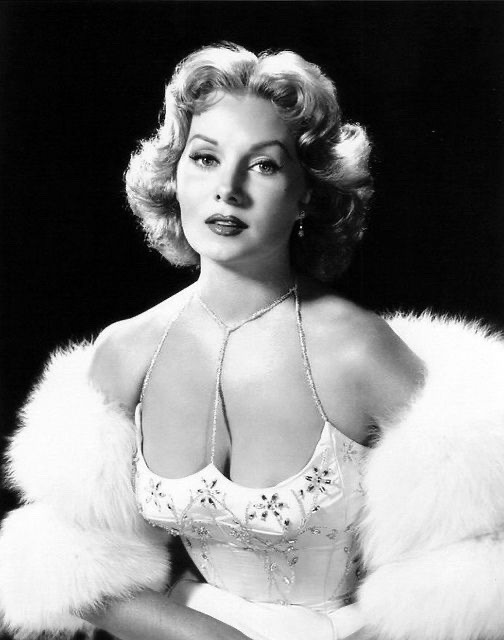
Rhonda Fleming (born Marilyn Louis; August 10, 1923 – October 14, 2020) was an American film and television actress and singer. She acted in more than 40 films, mostly in the 1940s and 1950s, and became renowned as one of the most glamorous actresses of her day, nicknamed the "Queen of Technicolor" because she photographed so well in that medium.
Fleming was born Marilyn Louis in Hollywood, California, to Harold Cheverton Louis, an insurance salesman, and Effie Graham, a stage actress who had appeared opposite Al Jolson in the musical Dancing Around at New York's Winter Garden Theatre from 1914 to 1915. Fleming's maternal grandfather was John C. Graham, an actor, theater owner, and newspaper editor in Utah.
She began working as a film actress while attending Beverly Hills High School, from which she graduated in 1941. She was discovered by the well-known Hollywood agent Henry Willson, who changed her name to "Rhonda Fleming".
"It's so weird", Fleming said later. "He stopped me crossing the street. It kinda scared me a little bit -- I was only 16 or 17. He signed me to a seven-year contract without a screen test. It was a Cinderella story, but those could happen in those days."
Fleming's agent Willson went to work for David O. Selznick, who put her under contract.[5][6] She had bit parts in In Old Oklahoma (1943), Since You Went Away (1944) for Selznick, and in When Strangers Marry (1944).
She received her first substantial role in the thriller, Spellbound (1945), produced by Selznick and directed by Alfred Hitchcock. "Hitch told me I was going to play a nymphomaniac", Fleming said later. "I remember rushing home to look it up in the dictionary and being quite shocked." The film was a success and Selznick gave her another good role in the thriller The Spiral Staircase (1946), directed by Robert Siodmak.
Selznick lent her out to appear in supporting parts in the Randolph Scott Western Abilene Town (1946) at United Artists and the film noir classic Out of the Past (1947) with Robert Mitchum and Kirk Douglas, at RKO, where she played a harried secretary.
Fleming's first leading role came in Adventure Island (1947), a low-budget action film made for Pine-Thomas Productions at Paramount Pictures in the two-color Cinecolor process and co-starring fellow Selznick contractee Rory Calhoun.
Fleming then auditioned for the female lead in a Bing Crosby film, a part Deanna Durbin turned down at Paramount in A Connecticut Yankee in King Arthur's Court (1949), a musical loosely based on the story by Mark Twain. Fleming exhibited her singing ability, dueting with Crosby on "Once and For Always" and soloing with "When Is Sometime". They recorded the songs for a three-disc, 78-rpm Decca album, conducted by Victor Young, who wrote the film's orchestral score. Her vocal coach in Hollywood, Harriet Lee, praised her "lovely voice", saying, "she could be a musical comedy queen". The movie was Fleming's first Technicolor film. Her fair complexion and flaming red hair photographed exceptionally well and she was nicknamed the "Queen of Technicolor", a moniker not worth much to her as she would have preferred to be known for her acting. Actress Maureen O'Hara expressed a similar sentiment when the same nickname was given to her around this time.
She then played another leading role opposite a comedian, in this case Bob Hope, in the The Great Lover (1949). It was a big hit and Fleming was established. "After that, I wasn't fortunate enough to get good directors", said Fleming. "I made the mistake of doing lesser films for good money. I was hot – they all wanted me – but I didn't have the guidance or background to judge for myself."
In February 1949, Selznick sold his contract players to Warner Bros, but he kept Fleming.
In 1950 she portrayed John Payne's love interest in The Eagle and the Hawk, a Western.
Fleming was lent to RKO to play a femme fatale opposite Dick Powell in Cry Danger (1951), a film noir. Back at Paramount, she played the title role in a Western with Glenn Ford, The Redhead and the Cowboy (1951).
In 1950, she ended her association with Selznick after eight years, though her contract with him had another five years to run.
Fleming signed a three-picture deal with Paramount. Pine-Thomas used her as Ronald Reagan's leading lady in a Western, The Last Outpost (1951), John Payne's leading lady in the adventure film Crosswinds (1951), and with Reagan again in Hong Kong (1951).
She sang on NBC's Colgate Comedy Hour during the same live telecast that featured Errol Flynn, on September 30, 1951, from the El Capitan Theater in Hollywood.
Fleming was top-billed for Sam Katzman's The Golden Hawk (1952) with Sterling Hayden, then was reunited with Reagan for Tropic Zone (1953) at Pine-Thomas. In 1953, Fleming portrayed Cleopatra in Katzman's Serpent of the Nile for Columbia. That same year, she filmed a western with Charlton Heston at Paramount, Pony Express (1953), and two films shot in three dimensions (3-D), Inferno with Robert Ryan at Fox, and the musical Those Redheads From Seattle with Gene Barry, for Pine-Thomas. The following year, she starred with Fernando Lamas in Jivaro, her third 3-D release, at Pine-Thomas. She went to Universal for Yankee Pasha (1954) with Jeff Chandler. Fleming also traveled to Italy to play Semiramis in Queen of Babylon (1954).
Fleming was part of a gospel singing quartet with Jane Russell, Connie Haines, and Beryl Davis.
Much of the location work for Fleming's 1955 Western Tennessee's Partner, in which she played Duchess opposite John Payne as Tennessee and Ronald Reagan as Cowpoke, was filmed at the Iverson Movie Ranch in Chatsworth, California, (known as the most heavily filmed outdoor location in the history of film and television). A distinctive monolithic sandstone feature behind which Fleming (as Duchess) hid during an action sequence, later became known as the Rhonda Fleming Rock. The rock is part of a section of the former movie ranch known as "Garden of the Gods", which has been preserved as public parkland.
Fleming was reunited with Payne and fellow redhead Arlene Dahl in a noir at RKO, Slightly Scarlet (1956). She did other thrillers that year; The Killer Is Loose (1956) with Joseph Cotten and Fritz Lang's While the City Sleeps (1956), co-starring Dana Andrews, at RKO. Fleming was top billed in an adventure movie for Warwick Films, Odongo (1956).
Fleming had the female lead in John Sturges's Gunfight at the O.K. Corral (1957) co-starring Burt Lancaster and Kirk Douglas, a big hit. She supported Donald O'Connor in The Buster Keaton Story (1957) and Stewart Granger in Gun Glory (1957) at MGM.
In May 1957, Fleming launched a nightclub act at the Tropicana in Las Vegas. It was a tremendous success. "I just wanted to know if I could get out on that stage – if I could do it. And I did! ... My heart was to do more stage work, but I had a son, so I really couldn't, but that was in my heart."
Fleming was Guy Madison's co star in Bullwhip (1958) for Allied Artists, and supported Jean Simmons in Home Before Dark (1958), which she later called her favorite role ("It was a marvellous stretch", she said).
Fleming was reunited with Bob Hope in Alias Jesse James (1959) and did an episode of Wagon Train.
She was in the Irwin Allen/Joseph M. Newman production of The Big Circus (1959), co-starring Victor Mature and Vincent Price. This was made for Allied Artists, whom Fleming later sued for unpaid profits.
Fleming travelled to Italy again to make The Revolt of the Slaves (1959) and was second billed in The Crowded Sky (1960).
In 1960, she described herself as "semi-retired", having made money in real estate investments. That year she toured her nightclub act in Las Vegas and Palm Springs.
During the 1950s, 1960s, and into the 1970s, Fleming frequently appeared on television with guest-starring roles on The Red Skelton Show, The Best of Broadway, The Investigators, Shower of Stars, The Dick Powell Show, Wagon Train, Burke's Law, The Virginian, McMillan & Wife, Police Woman, Kung Fu, Ellery Queen, and The Love Boat.
In 1958, Fleming again displayed her singing talent when she recorded her only LP, entitled simply Rhonda (reissued in 2008 on CD as Rhonda Fleming Sings Just For You). In this album, which was released by Columbia Records, she blended then-current songs like "Around The World" with standards such as "Love Me or Leave Me" and "I've Got You Under My Skin". Conductor-arranger Frank Comstock provided the musical direction.
On March 4, 1962, Fleming appeared in one of the last segments of ABC's Follow the Sun in a role opposite Gary Lockwood. She played a Marine in the episode, "Marine of the Month".
In December 1962, Fleming was cast as the glamorous Kitty Bolton in the episode, "Loss of Faith", on the syndicated anthology series, Death Valley Days, hosted by Stanley Andrews. In the story line, Kitty pits Joe Phy (Jim Davis) and Peter Gabriel (Don Collier) to run against each other for sheriff of Pima County, Arizona. Violence results from the rivalry.
In the 1960s, Fleming branched out into other businesses and began performing regularly on stage and in Las Vegas.
One of her final film appearances was in a bit-part as Edith von Secondburg in the comedy The Nude Bomb (1980) starring Don Adams. She also appeared in Waiting for the Wind (1990).
Fleming has a star on the Hollywood Walk of Fame. In 2007, a Golden Palm Star on the Palm Springs Walk of Stars was dedicated to her.
Fleming worked for several charities, especially in the field of cancer care, and served on the committees of many related organizations. In 1991, her fifth husband, Ted Mann, and she established the Rhonda Fleming Mann Clinic for Women's Comprehensive Care at the UCLA Medical Center.
In 1964, Fleming spoke at the "Project Prayer" rally attended by 2,500 at the Shrine Auditorium in Los Angeles, California. The gathering, which was hosted by Anthony Eisley, a star of ABC's Hawaiian Eye series, sought to flood the United States Congress with letters in support of mandatory school prayer, following two decisions in 1962 and 1963 of the United States Supreme Court, which struck down mandatory school prayer as conflicting with the Establishment Clause of the First Amendment to the United States Constitution.
Joining Fleming and Eisley at the rally were Walter Brennan, Lloyd Nolan, Dale Evans, Pat Boone, and Gloria Swanson. Fleming declared, "Project Prayer is hoping to clarify the First Amendment to the Constitution and reverse this present trend away from God." Eisley and Fleming added that John Wayne, Ronald Reagan, Roy Rogers, Mary Pickford, Jane Russell, Ginger Rogers, and Pat Buttram would also have attended the rally had their schedules not been in conflict.
Fleming married six times:
Thomas Wade Lane, interior decorator, (1940–1942; divorced), one son
Dr. Lewis V. Morrill, Hollywood physician, (July 11, 1952 – 1954; divorced)
Lang Jeffries, actor, (April 3, 1960 – January 11, 1962; divorced)
Hall Bartlett, producer (March 27, 1966 – 1972; divorced)
Ted Mann, producer, (March 11, 1977 – January 15, 2001; his death)
Darol Wayne Carlson (2003 – October 31, 2017; his death)
Through her son Kent Lane (b. 1941), Rhonda also had two granddaughters (Kimberly and Kelly), four great-grandchildren (Wagner, Page, Lane, and Cole), and two great-great-grandchildren.
She was a Presbyterian and a Republican who supported Dwight Eisenhower during the 1952 presidential election.
Fleming died on October 14, 2020, in Saint John's Health Center, Santa Monica, California, at the age of 97. She is interred at Hillside Memorial Park in Culver City, California.
#rhonda fleming#classic hollywood#classic movie stars#golden age of hollywood#old hollywood#1940s hollywood#1950s hollywood#1960s hollywood#1970s hollywood
40 notes
·
View notes
Text
Diamond in the Rough
“I was sitting in my office shooting paper clips at a King size horse fly. It was a little sadistic but he was bigger than I was. Well, about the time I had him down on his knees begging for mercy, the door opened…”
There’s nothing in Dick Powell’s early career to suggest he was destined to play hard-boiled private eyes. Had his bosses at Warner Brothers had their way, he’d have stayed in the song-and-dance roles on which he built his career. But thanks to a gamble by a director, Powell kicked off a new chapter to his career and the result were some great radio shows, including one of the medium’s best - Richard Diamond, Private Detective.
Powell got his start in Hollywood in the 30s as a singer in Warner Brothers musicals, including 42nd Street, and On the Avenue. He was frequently cast in the role of a boyish crooner, even as he approached his 40s. Despite his success, Powell was eager to expand into other roles. His efforts were resisted by Warner Brothers, who wanted to keep Powell right where he was, even if he thought it was the wrong place to be. He pursued the lead role in Double Indemnity, but it ultimately went to another actor pegged in “nice guy” roles - Fred MacMurray.
But later in 1944, RKO and director Edward Dmytryk gave Powell the role he’d been waiting for - Raymond Chandler’s Philip Marlowe in Murder, My Sweet, the film adaptation of the Marlowe novel Farewell, My Lovely. The film was a success, and Powell received rave reviews for his performance. In a flash, he had shed the crooner image he’d been desperate to shake and he embarked on the next stage of his career.
Powell recreated his role as Marlowe on the June 11, 1945 Lux Radio Theater broadcast of Murder, My Sweet, and he starred as private detective Richard Rogue in Rogue’s Gallery from 1945 to 1946. While it was a fine series, it failed to stand out from the crowd of hard-boiled private eyes littering the airwaves in the postwar years. For his next radio effort, Powell wanted to “make something a little bit different of a standard vehicle.” He recorded an audition show as “the man with the action packed expense account,” Johnny Dollar, but he passed on the series for a show that sprang from the mind of Blake Edwards. Edwards would later create the outstanding police procedural The Line-Up for radio, develop Peter Gunn for television, and would become a celebrated writer and director of film arguably most famous for the Pink Panther film series with Peter Sellers.
Powell and his producer, Don Sharp, asked Edwards if he had any ideas for a vehicle for Powell. Edwards said he did (a lie), and went home to write what would become the pilot for Richard Diamond, Private Detective. In Edwards’ original script, Diamond was a former OSS agent; he would evolve into an ex-cop. One trait he would retain as the script evolved was that Diamond was as quick with a quip as he was with his fists. This played to Powell’s natural comedic strengths, and it helped to give the show a unique voice in the sea of detective programs from the era. Unlike other radio shamuses, Diamond would keep up a friendly relationship with his old colleagues on the force - Lt. Walt Levinson, his former partner; and the oafish Sgt. Otis Ludlum, the long-suffering butt of Diamond’s jokes. Diamond flirted with every skirt that came through his office door, but he only had eyes for his Park Avenue girlfriend, Helen Asher. Shows would often close at her apartment, where Diamond would sum up his case and (in a nod to Powell’s old career) Helen might coax him to do a little singing.
Richard Diamond, Private Detective premiered on NBC on April 24, 1949. Powell was supported by Virginia Gregg as Helen; Ed Begley as Levinson; and Wilms Herbert doing double duty as Sgt. Otis and as Helen’s butler, Francis. Joseph Kearns, Peggy Webber, Bill Johnstone, Jack Kruschen, and other West Coast actors filled out the cast. Later in the show’s run, Frances Robinson would take over the role of Helen, and Ted de Corsia, Arthur Q. Bryan (Elmer Fudd), and Alan Reed (Fred Flinstone) would rotate in and out as Levinson.
The show ran without a sponsor for the first year before being picked up by the Rexall Drug Company (“Good health to all from Rexall!”) in June 1950. In January 1951, the show switched networks and picked up Camel cigarettes as its new sponsor. The show took its final bow on June 27, 1952 (although repeats popped up in the summer of 1953). Powell pulled the plug on the show as he entered a third phase of his career as a successful director and producer.
It was in this capacity that Powell brought Richard Diamond to television in 1957 for a four-season run starring David Janssen in the title role, minus the crooning of the radio series. Janssen would later star as Dr. Richard Kimble on The Fugitive. The Diamond TV show is perhaps best known today for its character of Diamond’s secretary, Sam, who was only shown from the waist down to show off her legs. The first actress to furnish Sam’s legs was a young Mary Tyler Moore.
In honor of his anniversary, here are ten of my favorite Richard Diamond radio adventures. Sit back and enjoy some sleuthing and singing with Dick Powell and company in these sensational stories.
"The Lillian Baker Case" - This one is a good showcase for Diamond's girlfriend Helen Asher, who gets to take a rare role in the case of the week. At a department store, Helen witnesses an elderly woman shoplifting. It turns out she's a wealthy eccentric, and later that afternoon she dies - allegedly after leaping from her balcony. (9/3/49)
"The Jerome J. Jerome Case" - Joseph Kearns plays the titular eccentric character - a man who claims to be a millionaire, a genius inventor, and a private detective. He wants to partner with Diamond, but as soon as the gumshoe tries to dismiss him it turns out the kook may have information about an actual murder. (9/17/49)
"The Louis Spence Case" - An unusual, but very exciting, episode finds Diamond racing against time to save his old friend Lt. Walt Levinson. A deranged bomber has escaped from prison, and he's taken the lieutenant hostage. Unless the mayor jumps to his death from city hall within the hour, the bomber will blow the precinct - and Walt - to kingdom come. (3/5/50)
"The Statue of Kali" - It's Richard Diamond's version of The Maltese Falcon (complete with Paul Frees doing his best Sydney Greenstreet). An ivory statue is delivered to Diamond by a dying man, and it's being hunted by nefarious characters from all around the world. (4/5/50)
"The Martha Campbell Kidnap Case" - Diamond is hired to deliver the ransom when a wealthy woman is kidnapped, but both he and the lady's nephew are knocked out, the ransom money is taken, and the kidnap victim is killed. Rick has to use some creativity and theatricality to figure out what happened. (7/26/50)
"The Oklahoma Cowboy Murder Case" - Diamond trades the bright lights of the big city for the clear skies of the plains in this episode that was later adapted as an episode of Peter Gunn. Rick heads west to investigate a suspicious death - a wealthy rancher who expired when he fell from his horse. (9/27/50)
"The Cover-Up Murders" - Rick and Walt partner again when a serial killer stalks the city. Part of his MO is to call the police and boast that he'll kill someone that night at eight o'clock. But what appears to be random madness may have a clear motive, and it's up to Diamond to stop the killings before more bodies drop. (11/22/50)
"Blue Serge Suit" - Jim Backus (later Mr. Howell on Gilligan's Island) is Diamond's new client - a tailor whose supply of blue serge is raided and stolen by intruders. When Diamond's own suit is snatched, he's on the trail of a gang of spies. (2/9/51)
"Lady in Distress" - A beautiful woman hires Diamond, and then she drops dead in his office. With nothing to go on - he didn't even know her name - Rick takes the case and tries to learn what had her so scared and what led to her death. It's a story that was recycled quite a few times. Jeff Regan and Johnny Dollar both solved variations of this script, but the Richard Diamond version is my favorite. (2/23/51)
"The Red Rose" - In another story later reworked as a TV episode of Peter Gunn, Diamond is hired to keep a client alive. The man hired a hit man to do away with himself, but he's had a change of heart. Unfortunately, the hit man is a committed professional and he intends to finish the job. (3/2/51)
Check out this episode!
9 notes
·
View notes
Text
Astaire & Rogers Rewatch Part 9: The Story of Vernon and Irene Castle
• It’s 1939. Fred Astaire and Ginger Rogers’ partnership was box office gold and literally kept RKO from bankruptcy. But the magic has fizzled out and both actors are ready to move on. So for their last musical together you pick… a historical re-telling of another famous dancing duo?
This probably made sense at the time because the Castles were well known and who else would possibly play them in a biopic but the best-known dancing duo of the time. But it makes for a very blasé film.
• I’ll say this for The Story of Vernon and Irene Castle, the relationship between Astaire and Rogers’ characters is far more relaxed. They’re a unit for most of the film, which is a nice change. A lot of their personal friendship and connection seeps into their scenes, I think.
The relationship also feels like a glimpse at what a real-life partnership between Astaire and Rogers might’ve looked like. In her autobiography, she theorizes that she and Astaire might’ve become a serious item had she stayed in New York and they’d continued dating. But instead, she went off to Hollywood.
• Apparently, Irene Castle was a bit of a nightmare for Rogers to deal with. She was incredibly nit-picky about the clothes Rogers wore because she (Irene) was a fashion icon in the 1910s, and since this was a tribute to her and her beloved husband, she was intent on getting her way.
Irene was also upset with the casting of white actor Walter Brennan as her faithful servant, Walter, who in real life was black. Irene and Vernon were responsible for making African American music like ragtime and jazz popular among whites and traveled with a black orchestra so the whitewashing of Walter possibly felt extra insensitive.
• It’s likely that without the Castles there would have been no Astaire/Rogers. The Castles helped legitimize “close dancing,” which was previously seen as scandalous, because they were so classy and respectable. They moved dancing along and then Astaire and Rogers moved it even further.
• Our characters/actors: Vernon Castle (Fred Astaire), Irene Castle (Ginger Rogers), Walter (Walter Brennan), Maggie Sutton (Edna May Oliver)
• I’ve said it before and I’ll say it again: don’t waste your time trying to make someone like you who is not interested and terrible. Just move on.
• Ah, the 1910s, when men wore suits to the beach.
• Is that dog the same one that Rogers had in Shall We Dance?
• Rescuing a dog at the beach is a special kind of meet-cute. Being harangued into spending the rest of the day with the other person’s overbearing family is less cute. Watching the woman you just met perform a weird af “Yama Man” routine while dressed as a clown is just freaky.
Vernon is rather high and mighty about being a “theatre actor” and Irene being an amateur when he’s the second comic in terrible slapstick shows. In fact, his comedy routine is horribly unfunny.
• Astaire does look rather right in the 1911 attire though and the peck on the cheek Vernon gives Irene is quite sweet.
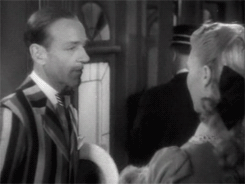
• I really enjoy how well they look together when practicing at her house.
• The lyrics “I can see myself doing the things I never could do, It’s true, But only when you’re in my arms” is fitting for Astaire, especially to sing to Rogers.
• The kiss they share after getting engaged is sweeter than the kiss in Carefree. Fight me.
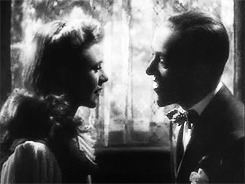
• I like how naturally she reaches for his hand and the way his thumb strokes her fingers. There’s a lot of quiet intimacy between them in this film.
• They really do a great job with the audition dance. You can see Astaire and Rogers themselves peek through when he spins her a few times. Their faces are just lit up. Home movies from this dance show they were having a pretty fun time.
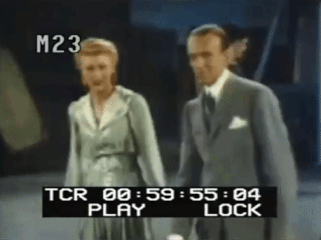
• The idea that no one would pay money to see a man dance with his own wife is ludicrous. Obviously, the Castles were a successful married dancing team. But more than that, you’re telling me that if Astaire and Rogers were married irl no one would want to see them dance together?
• I like how when asked whose idea it is that they dance together, they respond in unison, “Ours,” and then glance at each other. She turns back to the proprietor right after but he keeps gazing at her adoringly.
• The actress Edna May Oliver plays Maggie Sutton but all I can ever think of when I see her is Lady Catherine de Bourgh, whom she played in the 1940 Pride & Prejudice film.
Fun fact: The Castles real-life manager was an openly out lesbian named Elizabeth Marbury. One guess why that isn’t included in this 1939 film.
• The way Vernon (Astaire) watches her while she opens the present is very affectionate and loving.
• “Dance with me” is a line that’s repeated a few times in this film and it’s lovely.
• The Castle Walk is the move they invent to dance quietly and it was all the rage. By the time the Castles returned to New York the following year, they were massive celebrities. As we see in the dance montage, they popularized many forms of dance including the tango and foxtrot.
Speaking of the tango, Astaire gives Rogers a few flirtatious up and down looks during that dance.
• The dances in this film are all based on the Castles’ dances so it’s not the same as when Astaire rigorously choreographed routines specifically for himself and Rogers. However, they still manage to make the dances engaging and uniquely theirs.
• In “The Maxixe” dance, you can again see Astaire and Rogers as themselves peek through the acting as they grin at each other in a familiar way and he watches her appreciatively during some of the moves.
• While on the train, they sit side by side and his arm is looped through hers so his hand can rest atop hers. Sweet domesticity that we rarely get to see between Astaire and Rogers’ characters.
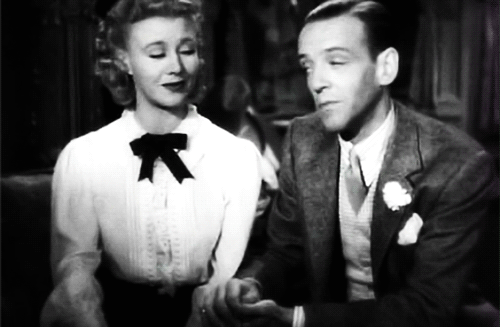
• When he explains to their agent that they want to slow down, he starts out by saying, “We’re in love…” Rogers turns to look at him and doesn’t look away for several seconds.
• Astaire gives a particularly athletic performance for the Royal Flying Corp. There are a lot of jumps and energetic moves and he nails them all.
• Irene was right that Vernon would make a good soldier. He was awarded the Croix de Guerre in 1917 and was later promoted to captain.
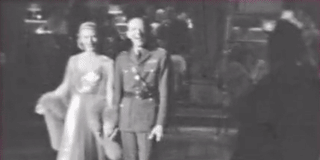
• Their dance when he’s in his uniform is another lovely duet (you can see some rare behind the scene footage above). It’s not like anything in their previous films, particularly because it is much more demur. But there are several gorgeous moments such as when he’s looking at her and she turns to face him and smiles softly. There’s also a stunning part where he lifts her from behind using only their connected hands and she leans back into his chest, laying her head on his shoulder.
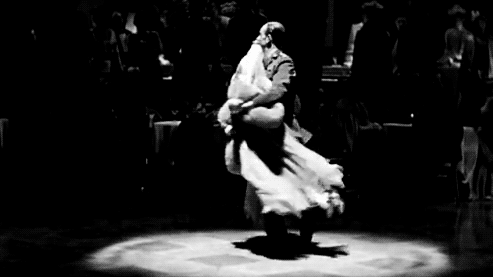
(gif credit)
• Vernon’s deadly crash was only deadly to him. The student pilot in the plane wasn’t seriously injured and neither was the pilot in the other plane. Vernon was 30 years old.
• In case it’s unclear, Vernon gave a list of songs for the orchestra to play and they are all songs that were meaningful to him and Irene. The ones we hear are: “By the Beautiful Sea,” which was playing the day they met, “By the Light of the Silvery Moon,” which he danced to at the train station, and “Only When You're in My Arms,” which he sang to her before proposing.
• And so the Astaire/Rogers partnership at RKO comes to an end as their characters dreamily dance into the horizon together. But don’t worry. Thanks to Gene Kelly’s broken ankle and Judy Garland’s unavailability, we’ll get to see Astaire and Rogers on screen together one last time. The Barkleys of Broadway is next and last.
#fred astaire#ginger rogers#the story of vernon and irene castle#classic hollywood#old hollywood#fred and ginger#astaire and rogers rewatch
21 notes
·
View notes
Text

Can Phoenix Wright perform a…

#rko auditions#phoenix wright#ace attorney#phoenix wright ace attorney#ace attorney phoenix wright#aa#ace attorney polls#naruhodo ryuichi#submitted by anonymous#character polls#fandom polls#poll time#polls#tumblr polls#poll blog#wrestling polls#poll game#hyper specific poll#wrestling#full disclosure#I’m an ace attorney fan#which is why I went for#that picture of Phoenix#lol
78 notes
·
View notes
Text
The Rocky Horror Show + Spongebob Squarepants
Ok, so as many of you already know, my boyfriend and I are ridiculously obsessed with Rocky Horror. We’re also huge Spongebob Squarepants fans. The thing is, during our last date, it finally happened. We related both stuff and came up with the greatest Spongebob episode ever. So I would like, if I may, to take you on a strange journey...
—Well, let me start by saying this is a golden age episode. It just is.
—Squidward is a Rocky fan. You know why? Because Squidward being a Rocky fan is way more in-character than him being an underwater directioner, and that happened in canon.
—So Mr. Krabs wants to find a way to make more money, as always. And Squidward suggests to stage a play.
—Mr. Krabs is reluctant. Squidward has to insist on how easy Rocky Horror is to do.
—He casually mentions the props and Mr. Krabs’ eyes go full dollar sign mode, like “Do you mean people will pay for tickets, food and old newspapers?”
—So they’re doing Rocky Horror.
—Plankton, of course, finds out. He’s also a Rocky Horror fan and he’s like “so Krabs thinks he can do a play like this justice, pfft.” But Karen reminds him that it could be a good opportunity to steal the secret formula.
—They do some auditions, but not a lot of people go and Mr. Krabs goes crazy when he finds out they expect to get paid.
—The only one who stays is Larry, who wants to be Rocky. Just to show off his muscles, you know?
—The Krusty Krab tripulation and co. will have to be the rest of the cast, though.
—Squidward is obviously going to be Frank N. Furter.
—Spongebob and Sandy are Brad and Janet.
—Patrick is Eddie.
—And, since she wants to be a star and Mr. Krabs is still a good father in this universe, Pearl gets to be Columbia.
—Mr. Krabs is planning to be the criminologist and Dr. Scott, because... how hard can it be?
—But they still need a Riff-Raff and a Magenta!
—That’s when Plankton and Karen show up. Mr. Krabs is a bit reluctant, again, but they’re really good, there’s no other option and Squidward insists he can tell Plankton actually cares.
—Spongebob is super excited and Squidward is a freaking gatekeeper. Their conversations during the rehearsals go like this:
“This is the part when we take our clothes off? *genuinely confused*”
“Spongebob, please! The Rocky Horror Show is way deeper than that. Even someone like you should be able to understand the beauty, the freedom, the poetry of this...”
“And then we take our clothes off, right?”
“*sigh* Yes, Spongebob. Then we take our clothes off.”
—It’s showtime! And everything looks cheap and awful. Mr. Krabs’ version of his two characters is just wearing a different moustache and the stage is almost falling apart.
—Spongebob and Sandy are terrible. He’s trying to make this deep, protective, masculine voice and whispers “did I say it right, Squidward?” after every line. Sandy is trying to act like the damsel in distress but she clearly thinks it’s ridiculous and all her lines sound so fucking fake.
—Pearl’s tap dance routine is hell. She makes the whole building jump with every step and, at the part when they reveal they’re eating Eddie, she runs away crying and almost drowns everyone. Also, she’s trying to force her cheerleading routine into everything, and Squidward can’t fire her because... well, Mr. Krabs won’t let him.
—Patrick just forgets he has to come to stage. Everyone stays frozen, waiting for him to enter scene and Squidward has to directly call him for him to go. He doesn’t even remember the lyrics.
—The Floorshow is starting and Riff-Raff and Magenta are nowhere to be seen. They’re obviously doing something to steal the formula. Squidward is mad af.
—At the end, Plankton and Karen show up, fully in character, just for the “FRANK N FURTER IT’S ALL OVER” part.
—Squidward is ready for his last big number, but Plankton and Karen aren’t following the script. They’ve spent the whole play turning the Krusty Krab into a spaceship that will fly directly to the Chum Bucket.
—Squidward is crushed. As the whole building flies to the other side of the street and the rest of his friends try to stop Plankton, he constantly tries to sing “I’m going home”, but at the end he just gives up because nobody is actually listening.
—The Krusty Krab lands on top of the Chum Bucket. With the secret formula on his hands, Plankton clims out the building and gets to the rooftop, as in a reference to Rocky carrying Frank’s body to the top of the RKO tower.
—Quickly, Spongebob grabs a water gun from the prop shop Mr. Krabs installed and shoots at him, finally making him fall and letting go of the formula. Him and Karen run away.
—Out of danger, everyone looks at Squidward, and he goes “wait, I can explain!” in hope of finally doing his last performance. But before he can even begin, everybody is clapping and cheering. That was the best, most realistic show ever.
—Squidward has succeed, somehow, and everybody’s happy.
#spongebob squarepants#spongebob#squidward#plankton#mr krabs#The Rocky Horror Picture Show#the rocky horror show
18 notes
·
View notes
Text
MURDER AT THE VANITIES
May 18, 1934
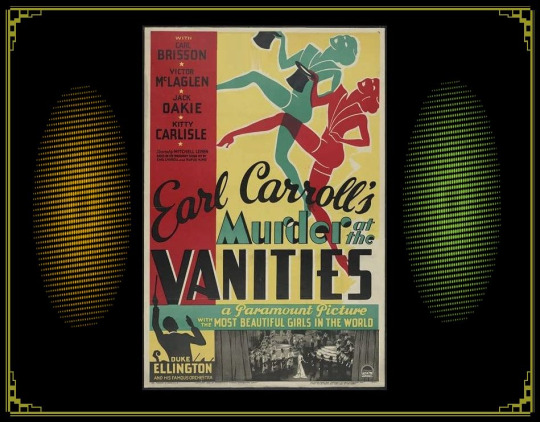
Director: Mitchell Leisen
Producer: E. Lloyd Sheldon for Paramount Pictures
Writers: Carey Wilson and Joseph Gollomb, based on the play by Earl Carroll and Rufus King
Synopsis ~ Shortly before the curtain goes up at Earl Carroll's Vanities, someone is attempting to injure leading lady Ann Ware, who wants to marry leading man Eric Lander. Stage manager Jack Ellery calls in his friend, policeman Bill Murdock, to help him investigate. They find the corpse of a murdered women. Bill suspects Eric of the crime, especially, after the second female lead Rita Ross told him she saw the women leaving from Eric's room. Rita is shot onstage with Eric's gun.
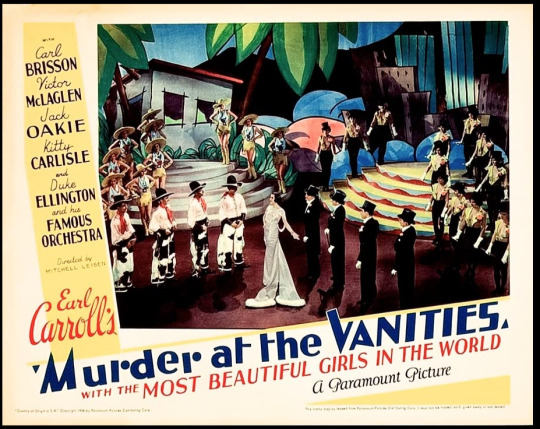
PRINCIPAL CAST
Carl Brissson (Eric Lander) was a Danish-born actor and singer making his only appearance with Lucille Ball. He would only make two more films before leaving film acting.
Victor McLaglen (Bill Murdock) would win an Oscar in 1936 for The Informer. He would be nominated again in 1953 for The Quiet Man. This is his only appearance with Lucille Ball.
Jack Oakie (Jack Ellery) would be seen with Lucille Ball in That Girl From Paris (1936) as well as both Annabel films (1938).
Kitty Carlisle (Ann Ware) made her film debut in this movie. She later married playwright Moss Hart and became an arts advocate. She was also frequently seen on talk, quiz, and panel shows. This is her only appearance with Lucille Ball.
Dorothy Stickney (Norma Watson) was a stage and screen actress making her only appearance with Lucille Ball.
Gertrude Michael (Rita Ross) was also seen with Lucille Ball in Hold That Girl, released two months earlier.
Jessie Ralph (Mrs. Helene Smith) was also seen with Lucille Ball in the 1934 films The Affairs of Cellini and Nana. In 1936 they appeared together in Bunker Bean.
Charles Middleton (Homer Boothby) was also seen with Lucille Ball in The Bowery (1933), followed by Nana and Broadway Bill, both in 1934.
Gail Patrick (Sadie Evans) would also be seen with Lucille Ball in 1937′s Stage Door.
Donald Meek (Dr. Saunders) appeared with Lucille Ball in The Whole Town’s Talking and Old Man Rhythm (both in 1935), as well as Having Wonderful Time (1938), and Du Barry Was A Lady (1943).
Toby Wing (Nancy) makes her only appearance with Lucille Ball.
Duke Ellington (Himself) was a composer, orchestra leader, and one of music’s most legendary personalities. This is his only time performing with Lucille Ball.
UNCREDITED CAST

Lucille Ball (Earl Carroll Girl) makes her ninth film since coming to Hollywood in 1933. Although she started out as a Goldwyn Girl at RKO, here she is a Earl Carroll girl at Paramount.
Ann Sheridan (Lou, Earl Carroll Girl) went on to a successful acting career known for her roles in the films San Quentin, Angels with Dirty Faces, They Drive by Night, The Man Who Came to Dinner, Kings Row, Nora Prentiss, and I Was a Male War Bride.
Virginia Davis (Earl Carroll Girl), as a child actress, was Walt Disney’s original Alice in Wonderland in a series of silent shorts from 1923 to 1925.
Other Earl Carroll Girls: Ernestine Anderson, Lona Andre, Marion Callahan, Nancy Caswell, Marguerite Caverley, Juanita Clay, Helen Curtis, Virginia Davis, Dorothy Dawes, Winnie Flint, Barbara Fritchie, Nora Gale, Zumetta Garnett, Gwenllian Gill, Ruth Hilliard (film debut), Inez Howard, Billie Huber, Diane Hunter, Constance Jordan, Evelyn Kelly, Patsy King, Iris Lancaster, Blanche McDonald, Leda Nicova, Wanda Perry, Rita Rober, Laurie Shevlin, Gwynne Shipman (film debut), Anya Taranda, Beryl Wallace (film debut), Dorothy White, Vivian Wilson, Gladys Young
Alan Ladd (Chorus Boy) found success in film in the 1940s and early 1950s, particularly in Westerns, such as Shane and in films noir. He was often paired with Veronica Lake in films such as This Gun for Hire, The Glass Key, and The Blue Dahlia.
Shep Houghton (Chorus Boy) also appeared with Lucille Ball in such films as Too Many Girls (1940), Lured (1947), Easy Living (1949), and Critic’s Choice (1963). On TV he appeared on two episodes of “The Lucy Show” and one “Here’s Lucy.” He was one of the Winkie Guards in The Wizard of Oz and a Southern Dandy in Gone With The Wind, both in 1939.
Other Chorus Boys: Dave O'Brien, Dennis O'Keefe, Frank Sully
Dancers in Ebony Rhapsody: Lucille Battle, Mildred Boyd, Gladys Henderson, Cleo Herndon, Ruth Scott, Carolynne Snowden
The King's Men (Lovely One Quartet)
OTHERS
Colin Tapley (Stage Manager)
Roy Crane (Assistant Stage Manager)
William Arnold (Treasurer)
Arthur Rankin (Assistant Treasurer)
Betty Bethune (Charwoman)
Howard M. Mitchell (Detective)
Mike Donovan (Police Sergeant)
Stanley Blystone (Policeman)
Mary Gordon (Assistant Wardrobe Woman)
Mildred Gover (Pearl)
Hal Greene (Call Boy)
Otto Hoffman (Walsh)
Mitchell Leisen (Orchestra Leader)
Charles McAvoy (Ben)
Ted Oliver (Murdock's Chauffeur)
Teru Shimada (Koto)
Cecil Weston (Miss Bernstein)

Many of the Earl Carroll Girls featured in the film were authentic cast members from Carroll's stage show, which ran on Broadway from November 1933 to March 1934. These cast members were brought out to Hollywood from New York especially for this film, and many stayed to pursue film careers. Earl Carrol Girls who appeared in the stage version of Murder at the Vanities, but not this film version, included Dudone Blumier, Eunice Coleman, Muriel Evans, Evalyn Knapp, Helene Madison, Lorna Rode and Marion Semle. Also in the cast was a Ruth Mann, who was probably Helen Mann.

The film was based on a Broadway production of the same name, but completely rewritten for the screen and with all new musical numbers.

In “The Audition” (ILL S1;E6) aired on November 19, 1951 Lucy says to Ricky: “I’ll bet if Ziegfeld or Earl Carroll had seen me, they’d sign me up like that!” She then puts a lampshade on her head and struts about the room in a moment recycled from the (then) unaired pilot.
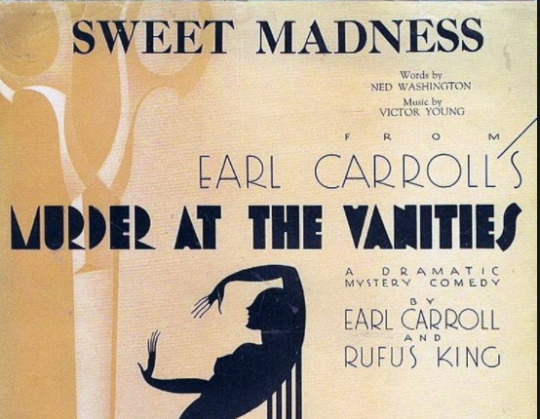
This film contains a song and dance number called “Sweet Marijuana”. It got past the censors because at the time the film was made, the drug was not illegal. Today, many prints omit this production number all together.

The film also introduced the standard “Cocktails for Two” by Arthur Johnston and Sam Coslow.

Gimbels in New York did a promotion in connection with the film, selling Mojud Clari-phane stockings using images of some of the Earl Carroll Girls. Sadly, Lucille Ball is not among them!

The film was a box office disappointment for Paramount.
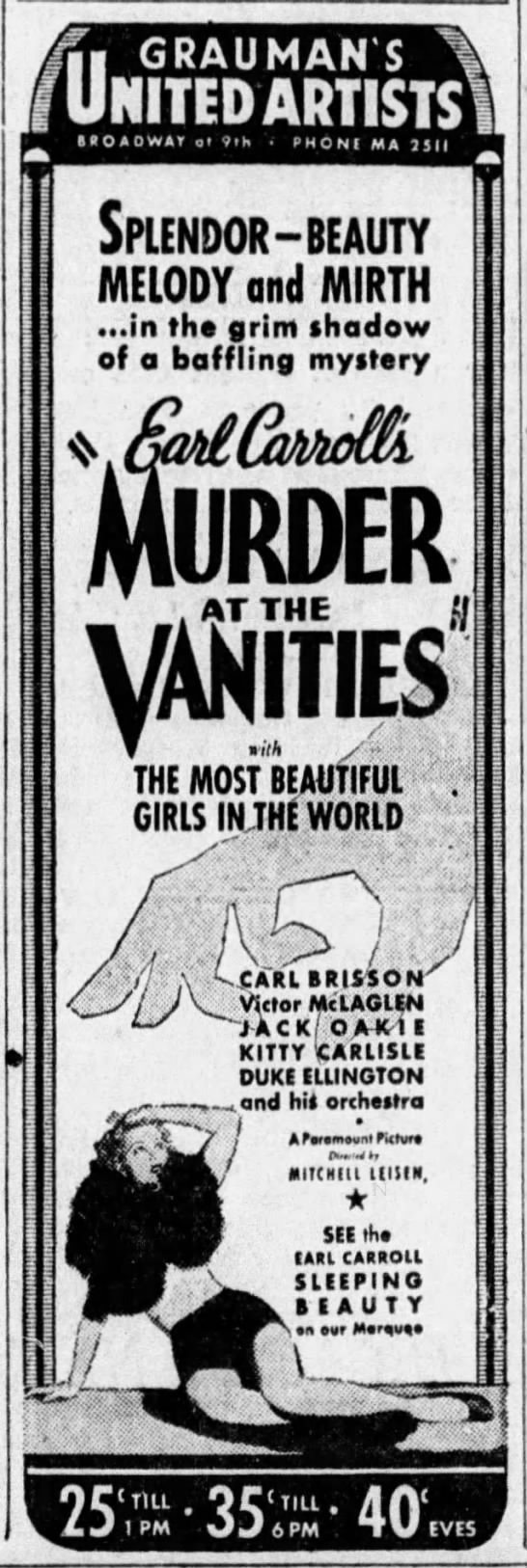
#Murder at the Vanities#Lucille Ball#Earl Carroll#1934#Duke Elliington#Shep Houghton#Kitty Carlisle#Jack Oakie#Alan Ladd#Ann Sheridan
8 notes
·
View notes
Text
tragic beauty: lupe vélez - an analysis
“I had to play with boys, girls found me too rough.” - Lupe Vélez
This is an analysis I’ve wanted to cover for a while for quite a few reasons. Primarily because, in a few ways, I see myself in her and, as such, feel the need to defend her and assert her true legacy: as a pioneer. Which brings me to the main reason I wanted to do this: to correct the scurrilous rumours about her premature death cooked up by a hating ass imbecilic Aquarius whose infamous book doesn’t deserve to be named. So if you want to hear the truth about this lady, read on.
Known as the “Mexican Spitfire”, Latin bombshell Lupe Vélez was (an to an extent, still is) a much-maligned and terribly misunderstood woman. A true Cancer, she was a force of nature and unconsciously antagonized others and made them uncomfortable because of her authenticity to herself and her emotional nature. Born during a storm, she had a naturally stormy personality. She could be hilarious and charismatic one moment, and depressive and vicious the next. Instead of anyone trying to understand her, they just stuck her with the “spicy fiery Latina” stereotype, not knowing or caring what was behind it. The harshness of her life before stardom may explain some of her fearsome, yet fun, personality; she grew up with violent trauma – watching her father kill and almost be killed during the Mexican Revolution. She also is believed to have had undiagnosed bipolar disorder, which would explain her extreme moodiness and outbursts.
One of the first Latina actresses to make an impact in Hollywood, she was subjected to the racist, sexist Hollywood tropes that forever typecasted her—she was called “senorita cyclone,” and the “hot tamale”. The Hollywood press willfully misunderstood Vélez’s sex positivity and consistently portrayed her as a woman who took great pleasure in her body, and indeed, the tempestuous Vélez had numerous affairs, including a particularly torrid one with a young Gary Cooper, and a tumultuous marriage to “Tarzan” star Johnny Weissmuller. But in 1944, at age 36, she found herself pregnant with the child of a little known-actor name Harald Ramond, who would not marry her and this reality made her come undone, and like my other baby Carole Landis, she succumbed to an drug overdose. Her promiscuity, right or wrong, became part of the way her stardom was packaged and promoted. Also, the press naturally compared her to (and pitted her against) Hollywood’s only other female Mexican star—the “high-class” and elegant Dolores Del Rio. The press couldn’t even find sympathy for her even in death and a false story was printed that she drowned in the toilet after vomiting up a spicy Mexican dinner. Her death is parodied and mocked to this day. Again, she’s a true Cancer in the sense that the same imperfections that everyone else has, she is seen as less than human for having them. I hope to help right that wrong by honoring Vélez for being the trailblazer that she is. At any rate, Vélez would seem to be a prototype for contemporary female stars, from Madonna to Rihanna, who have proclaimed their pleasure in their body and their sexual liberation — a pro-sex activist before her time, doomed to suffer the rejection of a more puritanical age.
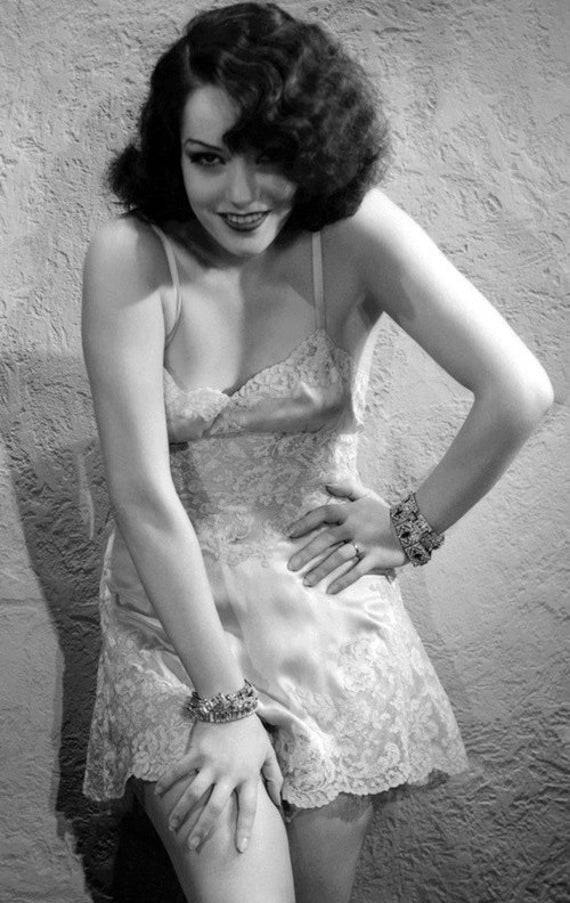
Lupe Vélez, according to astrotheme, was a Cancer sun and Leo moon. She was born María Guadalupe Villalobos Vélez in San Luis Potosí, Mexico, to young upper-middle class parents. Her father, Jacobo Villalobos Reyes, was a colonel in the military, and her mother, Josefina Vélez, was an opera singer. They also had another son, John and daughter, Annette. The Villalobos family were considered prominent in San Luis Potosí and most of the male family members were college educated. The family was also financially comfortable and lived in a large home with servants. As a young girl Lupe showed an interest in performing, but her father was outraged at his daughter’s “low-class” dreams, and forbade his daughter from being in show business. All that changed during the war. Her family was in a state of upheaval—the Mexican Revolution was happening, her father had been presumed dead in the war and all their money was gone. While most of her family members were too proud to get jobs, a teenage Vélez did just that, supporting the family by working as a saleswoman in a department store. She then finagled an audition with a local theater. However, her father was indded alive and well and soon returned home from the war. Because at that time becoming an artist and coming from a well-to-do family was seen as embarrassing, her father refused to let her use his last name in theater, so she used her mother’s surname.
She proceeded to seek out venues where she could dance the then-popular “shimmy.” In 1925 she was cast in the big stage revues Mexican Rataplan and !No lo tapes! and became a big audience favourite. Her name got around to American stage star Richard Bennett (father of American film stars Constance and Joan Bennett), who was looking for a Mexican cantina singer for his new play. Lupe traveled to Hollywood but was rejected for the part for being too young. While in Hollywood, Lupe met film and stage comedienne Fanny Brice, who took a liking to Lupe because of her sparkling personality. She put in a good word for Lupe to impresario Florenz Ziegfeld (creator of the Ziegfeld’s Follies), who could use Lupe in one of his Broadway musicals. However, MGM producer Harry Rapf heard of Lupe as well, and offered her a screen test. When producer Hal Roach saw the test, he immediately signed her to a contract. Vélez soon made her major film debut in Douglas Fairbanks’ action-romance The Gaucho in 1927. The film was a huge hit and Vélez was an overnight sensation.
Along with her professional life gaining steam, so did her love life. Vélez sought out some of Hollywood’s hottest men, which wasn’t hard for a hot and sexy number like Lupe; men flocked to her like bees to honey. She was romantically linked with Gary Cooper, Charlie Chaplin, Clark Gable, cowboy Tom Mix, “Tarzan” actor Johnny Weissmuller, Errol Flynn, John Gilbert, Henry Wilcoxon, singer Russ Columbo, Randolph Scott, author Erich Maria Remarque (who wrote All Quiet On The Western Front and later married Paulette Goddard), Clayton “Lone Ranger” Moore, director Victor Fleming (director of Gone With The Wind), and boxers Jack Johnson and Jack Dempsey.
One of her first conquests was cowboy star Tom Mix. She also had an with newcomer Clark Gable, who cut off their romance because he was afraid Lupe would run all over town discussing their sexual secrets, which she did. Soon she had a torrid affair with comic genius Charlie Chaplin in 1928. Lupe revitalized Chaplin’s libido after he had gone through a torturous divorce from his wife. Whatever time she had for the many men in her life, that same appreciation didn’t extend to other women and she would frequently battle with the other females with whom she had to work with and would often threaten them; when she was starring in director D.W. Griffith’s Lady of the Pavements, she had to co-star with an actress named Jedda Goudall, whom she hated, and the two had a ferocious cat-fight on the set. When she made her final appearance on Broadway in the Cole Porter musical “You Never Know”, Vélez and fellow cast member Libby Holman feuded viciously. The feud came to a head during a performance where Vélez punched Holman in between curtain calls and gave her a black eye, which pretty much ended the run of the show. Vélez was territorial about the men in her life, she was vicious toward any woman who might be competition for her man or an acting role. She mocked Marlene Dietrich, Greta Garbo, Katharine Hepburn and Shirley Temple, and her arch nemesis Dolores Del Dio by doing imitations of them.
When she was cast in the film The Wolf Song in 1929, she met Gary Cooper and immediately started what would be her first widely publicized romance. Theirs was a one-sidedly volatile relationship; he would often appear in public with scratches and bruises. One time, she attacked him with a knife during a fight. He needed stitches. By the end of their time as a couple, Copper had lost 45 pounds and was physically exhausted. He was ordered by the studio to take a vacation. As he boarded a train, Vélez shot at Cooper but missed. Lupe soon moved on to other men; she had a thing for fighters. In addition to having a brief fling with boxer Jack Dempsey, she conducted a flagrant, but secret, affair with the black boxer Jack Johnson. In those days, blacks and whites almost never conducted sexual affairs out in the open. She met Olympic swimming champion Johnny Weissmuller at the hotel where she was staying that was owned by film star Marion Davies. One problem: Weissmuller was already married. But no matter, he dumped his wife for Lupe and married her October 8, 1933 in Las Vegas. Theirs was not a happy, serene marriage, and they constantly battled, with Lupe filing for divorce several times in 1934 and changing her mind each time. Weissmuller’s patience was so strained he dumped a plate of salad on her head at Ciro’s nightclub. Finally, in 1938 she filed a petition that was finalized in 1939.
After having many hit pictures with MGM, they unceremoniously dropped her. The excuse was that the studios were no longer going to make Spanish versions of their films and there was no longer a need for Latin actresses. Vélez returned to Mexico in 1938 to star in her first Spanish-language film. Arriving in Mexico City, she was greeted by 10,000 fans. The film La Zandunga, was a critical and financial success and Vélez was slated to appear in four more Mexican films, but instead, she returned to Los Angeles. She soon went to RKO Studios and starred in the B-movie The Girl From Mexico. Despite its lowly status, the picture became a tremendous hit with audiences. RKO rushed her into another film, this time called Mexican Spitfire, playing an emotionally volatile singer named Carmelita. The 1940 film became another smash for Lupe. The Spitfire series of eight slapstick comedy films rejuvenated Lupe’s sagging career. In late 1941, she had an affair with writer Erich Maria Remarque whose wife, actress Luise Rainer later wrote that Remarque told her “with the greatest of glee” that he found Vélez’s volatility hot.
At this same time Lupe took on another lover in the form of a French 27-year-old bit actor named Harald Ramond. He was a strong and controlling man who knew how to tame Lupe. After she discovered that she was three months pregnant, she announced her engagement to Ramond without his knowledge or consent. When he learned of her pregnancy, he refused to marry her. Deeply hurt and stunned, she felt backed into a corner; she knew her career would be ruined in Hollywood if word got out she was pregnant and unmarried. It just wasn’t done in those days. And despite her wildness, Lupe was a devout Catholic, so abortion was out of the question. She could see only one way out: suicide. On December 18, 1944, at the age of 36, Vélez swallowed 70 Seconal pills, she lay down on her pink satin pillow on her over-sized Hollywood bed and arranged herself like a movie star, with her hands folded across her chest and went into an eternal sleep. Dramatic to the end, Lupe went out of this world in glamorous style. She left a suicide note addressed to Harald, which read:
“To Harald, May God forgive you and forgive me too, but I prefer to take my life away and our baby’s before I bring him with shame or killing him. How could you, Harald, fake such a great love for me and our baby when all the time you didn’t want us? I see no other way out for me so goodbye and good luck to you, Love Lupe.”
THAT is the truth. But the bottom line is: how she lived her life as well as the circumstances around her death are all irrelevant at the end of the day. What matters is the loss of a great multi-talented, pioneering Mexican star and a legacy unrealized and stunted by a world that wasn’t ready for her.
Next, I’ll talk about the most famous of her paramours, the yin to her yang, a perfect example of the special chemistry that Taureans and Cancers share, the strong, silent hero of the silver screen: Taurus Gary Cooper.

Stats
birthdate: July 18, 1908
major planets:
Sun: Cancer
Moon: Leo
Rising: Gemini
Mercury: Cancer
Venus: Leo
Mars: Pisces
Midheaven: Pisces
Jupiter: Virgo
Saturn: Aries
Uranus: Capricorn
Neptune: Cancer
Pluto: Gemini
Overall personality snapshot: She may have seemed at times to be a shy, vulnerable, romantic individual who only wanted to please, but underneath she had a voracious appetite for adoration and respect, and would not stop until she got it. Without a doubt, she had a very warm feeling for others, and domestic security with plenty of happy togetherness is high on her list of priorities. When it came to cooperation with others, however, she had her limits because she was profoundly individualistic and, albeit in a charming manner, she insisted on doing things her way. Ultimately the most important thing for her was believing in herself and being true to her standards and aspirations. Most of all, she needed to fulfill her creative potential, which was like an intimate companion with whom she shared her life. You nurture it, protect it, and then you show it off, and whatever walk of life you are in, you tend to be a fine performer.
This gave her a lot of self-respect and a touch of vanity as well, and her emotional sensitivity combined with her underlying imperiousness tended to impress others and made them take her seriously. She was a devoted member of her flock, and she zealously and jealously protected and promoted whomever she was devoted to. When it came to developing her own talents, however, she seemed to know that she had to pull away in order to grow into her greatest self. Others may have thought she was a bit of a show-off but that was not the case: she simply had a deep sense of the importance of her own creative talents, and she felt only half alive if she did not honour them. Although she was pretty sensitive to criticism or rebuffs, she was just as committed to honesty and personal integrity; and despite her vanity, she eventually learned to laugh at herself.
She had a very good memory and found it easy to learn subjects that interested her. She was very kind and thoughtful towards others. Her imagination was very keen, but if it got carried away, she may have experienced irrational fears. Even though she may have tried to maintain a scientific and objective outlook, her mind was actually dominated by her emotions. When it came to careers, she may have felt initially vague or confused about what she really wanted to do. She was eventually forced to give up her career of choice by events out of her control (as was evidenced by the tides turning from the “Mexican spitfire” female ideal due to the changing of the times). There was probably some element of self-sacrifice involved somewhere in her choice of career (the element of sacrifice being that she had to sacrifice her child, and ultimately her life, in relation to her reputation as an unwed mother as well as her unborn child’s reputation as an illegitimate child). She had good technical and scientific ability due to her, at times almost fanatical, attention to detail. She was also fastidious when it came to matters of health, diet and appearance. She was not afraid of work and was very resourceful and capable. She also worked well in a team. She became very annoyed if somebody else questioned the way that she operated. Her energy levels were somewhat inhibited, her self-confidence reduced, and her ambitions restricted through fear of failure. Times of strength and weakness alternated within her. Even though her decision-making ability could be ineffectual through over-caution, she often seemed to be placed in situations where a quick decision was needed. When she succeeded, it was mainly through her own efforts. She also showed a tendency towards wanting to start at the top, wanting to avoid the hard work that gets you there.
She belonged to a generation with a rational and logical attitude to life. There was a conflict between tradition and convention, and the experimental and unconventional. As an individual, she had to learn to strike a balance between the erratic and the conventional. As a member of this generation, she had the ability to come up with original ideas which could be of practical value. She was part of a very artistically talented and creative generation that wanted to escape from the demands of the world around them into a world of excitement and glamour. She was part of an emotionally sensitive generation that was extremely conscious of the domestic environment and the atmosphere surrounding her home place and home country. In fact, she could be quite nostalgic about her homeland, religion and traditions, often seeing them in a romantic light. She felt a degree of escapism from everyday reality, and was very sensitive to the moods of those around her. Bow embodied all of these Cancer Neptunian ideals. As a Gemini Plutonian, she was mentally restless and willing to examine and change old doctrines, ideas and ways of thinking. As a member of this generation, she showed an enormous amount of mental vitality, originality and perception. Traditional customs and taboos were examined and rejected for newer and more original ways of doing things. As opportunities with education expanded, she questioned more and learned more. As a member of this generation, having more than one occupation at a time would not have been unusual to her.
Love/sex life: It wasn’t easy to be passionate and emotionally explosive and also hold on to her dignity, but this was what she wanted to accomplish. She tried to conceal the pulsating softness of her sexual nature behind a façade of control and bluster. She thought that her display of strength and jolly self-confidence would hide her vulnerability and her susceptibility to virtually any sexual diversion. Of course, no one was really buying this cover up. They saw the luscious edges of her erotic hunger peeking through her disguise. That’s why they were all so anxious to be around her. The biggest problem in her sex life was how to deal with change. She loved it and she hated it. She loved following the lead of her feelings and surrendering herself to the moment. Too much consistency, even loving consistency, was apt to leave her bored and dissatisfied. But she also saw change as a threat to her sense of control and to the emotional security that she valued so highly. Because of this duality in her thinking, her reaction to changes in her sex life was abrupt, contradictory, and (horror of horrors) a little undignified.
minor asteroids and points:
North Node: Gemini
Lilith: Libra
Vertex: Scorpio
Fortune: Gemini
East Point: Gemini
Her North Node in Gemini dictated that she needed to prevent her idealism from influencing her thoughts to such a high degree. She needed to consciously develop a more clear-minded and analytical approach involving her thought processes. Her Lilith in Libra was definitely working overtime here. Relationships somehow caused her to err, and her partner choices caused much suffering. She expressed herself through others. As a lover, she was aggressive, yet co-dependent. As a mistress, she was not above trying to cause a divorce, which she did with Johnny Weissmuller and she ultimately became fatally despondent when she found herself pregnant with a bit actor's baby. She used her good looks as a weapon to help her get ahead in the movie industry. Also, Lilith in Libra strangely enough, manifested itself as a sort of lighter female Capricorn archetype, and she pulled herself up by the bootstraps in a rather glamorous way, going to work after her father left the family unit. As such, she exhibited graceful gumption right until the very end. Her Vertex in Scorpio, 5th house dictated that she had a desire or continual need for feeling irresistible and irreplaceable on all levels of intimacy, whether spiritual, intellectual, emotional, or physical. From the fires of hell to the heights of heaven, the further and deeper the range of interaction she could experience with another the more fulfilling. She had a childlike orientation, in all of its manifestations, toward relationships on an internal level. That implicit trust, or perhaps naivete, that was instilled in our childhood persisted far into maturity. The concomitant explosions and occasional tantrums when these constructs are violated also accompany this position. She had a need for fun, creativity, and excitement in a committed relationship, no matter how many years it has endured. She often had deep fears, typical of children, of abandonment, as well as a need for universal acceptance, no matter how she acted, which she needed her partner to respect and nurture, rather than rebuke, especially in adulthood. Her Part of Fortune in Gemini and Part of Spirit in Sagittarius dictated that her destiny lay in travel, education and communication. She was able to overcome enemies by her words and by her writing. Happiness and fulfillment came from being able to express herself fully. Her soul’s purpose lay in seeking truth, justice and fairness. She felt spiritual connections and saw the spark of the divine when she studied, broadened her mind through new philosophies, or looked for inspiration outside the home. East Point in Gemini dictated that she was often insatiably curious and loved to collect little bits of (what seemed to be useless) information and trivia. Her interests were quite varied, and she may have been somewhat scattered. Sometimes her curiosity could appear cold and callous as her level of objectivity was potentially high. There was usually an openness to learning in any situation.
elemental dominance:
water
fire
She had high sensitivity and elevation through feelings. Her heart and her emotions were her driving forces, and she couldn’t do anything on earth if she didn’t feel a strong effective charge. She needed to love in order to understand, and to feel in order to take action, which caused a certain vulnerability which she should (and often did) fight against. She was dynamic and passionate, with strong leadership ability. She generated enormous warmth and vibrancy. She was exciting to be around, because she was genuinely enthusiastic and usually friendly. However, she could either be harnessed into helpful energy or flame up and cause destruction. Ultimately, she chose the latter. Confident and opinionated, she was fond of declarative statements such as “I will do this” or “It’s this way.” When out of control—usually because she was bored, or hadn’t been acknowledged—she was bossy, demanding, and even tyrannical. But at her best, her confidence and vision inspired others to conquer new territory in the world, in society, and in themselves.
modality dominance:
mutable
She wasn’t particularly interested in spearheading new ventures or dealing with the day-to-day challenges of organization and management. She excelled at performing tasks and producing outcomes. She was flexible and liked to finish things. Was also likely undependable, lacking in initiative, and disorganized. Had an itchy restlessness and an unwillingness to buckle down to the task at hand. Probably had a chronic inability to commit—to a job, a relationship, or even to a set of values.
house dominants:
2nd
3rd
1st
The material side of life including money and finances, income and expenditure, and worldly goods was emphasized in her life. Also the areas of innate resources, such as her self-worth, feelings and emotions were paramount in her life. What she considered her personal security and what she desired was also paramount. Short journeys, traveling within her own country were themes throughout her life; her immediate environment, and relationships with her siblings, neighbours and friends were of importance. The way her mental processes operated, as well as the manner and style in which she communicated was emphasized in her life. As such, much was revealed about her schooling and childhood and adolescence. Her personality, disposition and temperament is highlighted in her life. The manner in which she expressed herself and the way she approached other people is also highlighted. The way she approached new situations and circumstances contributed to show how she set about her life’s goals. The general state of her health is also shown, as well as her early childhood experiences defining the rest of her life.
planet dominants:
Neptune
Mercury
Sun
She was of a contemplative nature, particularly receptive to ambiances, places, and people. She gladly cultivated the art of letting go, and allowed the natural unfolding of events to construct her world. She followed her inspirations, for better or for worse. She was intellectual, mentally quick, and had excellent verbal acuity. She dealt in terms of logic and reasoning. It was likely that she was left-brained. She was restless, craved movement, newness, and the bright hope of undiscovered terrains. She had vitality and creativity, as well as a strong ego and was authoritarian and powerful. She likely had strong leadership qualities, she definitely knew who she was, and she had tremendous will. She met challenges and believed in expanding her life.
sign dominants:
Cancer
Gemini
Leo
At first meeting, she seemed enigmatic, elusive. She needed roots, a place or even a state of mind that she could call her own. She needed a safe harbor, a refuge in which to retreat for solitude. She was generally gentle and kind, unless she was hurt. Then she could become vindictive and sharp-spoken. She was affectionate, passionate, and even possessive at times. She was intuitive and was perhaps even psychic. Experience flowed through her emotionally. She was often moody and always changeable; her interests and social circles shifted constantly. She was emotion distilled into its purest form. She ventured out to see what else was there and seized upon new ideas that expanded her community. Her innate curiosity kept her on the move. She used her rational, intellectual mind to explore and understand her personal world. She needed to answer the single burning question in her mind: why? This applied to most facets of her life, from the personal to the impersonal. This need to know sent her off to foreign countries, where her need to explore other cultures and traditions ranked high. She was changeable and often moody. This meant that she was often at odds with herself—the mind demanding one thing, the heart demanding the opposite. To someone else, this internal conflict often manifested as two very different people. She loved being the center of attention and often surrounded herself with admirers. She had an innate dramatic sense, and life was definitely her stage. Her flamboyance and personal magnetism extended to every facet of her life. She wanted to succeed and make an impact in every situation. She was, at her best, optimistic, honorable, loyal, and ambitious.
Read more about her under the cut.
Lupe Velez was born on July 18, 1908, in San Luis Potosi, Mexico, as Maria Guadalupe Villalobos Velez. She was sent to Texas at the age of 13 to live in a convent. She later admitted that she wasn't much of a student because she was so rambunctious. She had planned to become a champion roller skater, but that would change. Life was hard for her family, and Lupe returned to Mexico to help them out financially. She worked as a salesgirl for a department store for the princely sum of $4 a week. Every week she would turn most of her salary over to her mother, but she kept a little for herself so she could take dancing lessons. With her mature shape and grand personality, she thought she could make a try at show business, which she figured was a lot more glamorous than dancing or working as a salesclerk. In 1924 Lupe started her show business career on the Mexican stage and wowed audiences with her natural beauty and talent. By 1927 she had emigrated to Hollywood, where she was discovered by Hal Roach, who cast her in a comedy with Stan Laurel and Oliver Hardy. Douglas Fairbanks then cast her in his feature film The Gaucho (1927) with himself and wife Mary Pickford. Lupe played dramatic roles for five years before she switched to comedy. In 1933 she played the lead role of Pepper in Hot Pepper (1933). This film showcased her comedic talents and helped her to show the world her vital personality. She was delightful. In 1934 Lupe appeared in three fine comedies: Strictly Dynamite (1934), Palooka (1934) and Laughing Boy (1934). By now her popularity was such that a series of "Mexican Spitfire" films were written around her. She portrayed Carmelita Lindsay in Mexican Spitfire (1940), Mexican Spitfire Out West (1940), The Mexican Spitfire's Baby (1941) and Mexican Spitfire's Blessed Event (1943), among others. Audiences loved her in these madcap adventures, but it seemed at times that she was better known for her stormy love affairs. She married one of her lovers, Johnny Weissmuller, but the marriage only lasted five years and was filled with battles. Lupe certainly did live up to her nickname. She had a failed romance with Gary Cooper, who never wanted to wed her. By 1943 her career was waning. She went to Mexico in the hopes of jump-starting her career. She gained her best reviews yet in the Mexican version of Naná (1944). Bolstered by the success of that movie, Lupe returned to the US, where she starred in her final film as Pepita Zorita, Ladies' Day (1943). There were to be no others. On December 13, 1944, tired of yet another failed romance, with a part-time actor named Harald Maresch, and pregnant with his child, Lupe committed suicide with an overdose of Seconal. She was only 36 years old. (x)
30 notes
·
View notes
Text
Just Give Her the Spotlight - The Marvelous Mrs. Miller By Constance Cherise
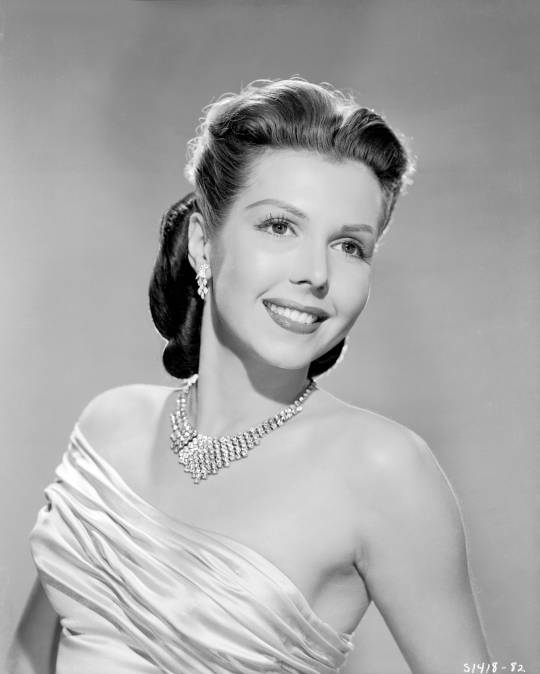
In 1987 at the age of 64, legendary tap dancer Ann Miller performed “Shakin’ the Blues Away” on the television special Happy 100th Birthday, Hollywood. In 1988, Miller performed a medley from the nine-year running production “Sugar Babies” on the Palladium stage along with Mickey Rooney, and in 1989 she performed the tap dance routine from 42ND STREET (‘33) for the Disney-MGM Studios Theme Park Grand Opening television special.
While recently watching these productions, I feared that I was going to witness a frail elderly woman, who was still convinced she “had it,” either embarrass or hurt herself. Thankfully, my future 64-year-old self is encouraged to say I was utterly wrong.
I watched each performance with unblinking eyes, in complete shock and jaw-dropping disbelief. Generally, mature performers are surrounded by dancers and ornamentation as distraction, while the older dancer waves their arms and kick their feet a time or two then get whisked off stage. Not so with Ann Miller. It’s true, a bevy of tap dancers joins her, but they are only for Broadway effect. She owns every performance, complete with her rapid-fire footwork and powerful Broadway belt (and when I state the term “belt,” I do not mean she sang well for her age, I mean “where did that voice come from Ethel Merman belt”). Miller claimed she never had to practice vocalizing, that her power came naturally. I suppose being used to many stars that were dubbed, I never questioned whether Miller’s voice was actually being used during her performances. I was too busy dissecting her dazzling costumes, lavish sets and trying to figure out how she could possibly execute gun-machine taps and appear as if her feet did not leave the ground.

Houston-born Johnnie Lucille Collier (her father anticipated a boy) aka Ann Miller was enrolled in dance school from the age of six. And, after confronting her philandering father who was caught red-handed with a nude woman in his bed, Miller and her mother of Cherokee descent, Clara, moved to California.
The naturally adept Miller eventually won a contest where she appeared for two weeks at the Orpheum Theatre. At 13 years old while performing at a supper club, Miller was discovered by talent scout Benny Rubin and comedienne Lucille Ball, who suggested she test with RKO. Required to prove her age, Miller enlisted her father, a criminal lawyer whose clients included Clyde Barrow and Bonnie Parker (yes, that Bonnie and Clyde), to provide a false birth certificate stating she was 18 years old. As she began quite young in films, her mother Clara was her constant companion and protector, a memory that Miller would speak fondly of. The two remained close until Clara’s passing. Miller worked for multiple studios including RKO, Columbia and MGM, toured with major Broadway productions and had numerous television appearances.
Her debut was an uncredited role in ANNE OF GREEN GABLES (‘34). She performed on Broadway at age 16, and after a two-year stint she returned to Hollywood. She mainly appeared in B films until she auditioned for MGM’s EASTER PARADE (‘48), where she performed the entertaining number “Shaking the Blues Away.” In an interview with Robert Osborne, Miller admits to performing the number in a brace, due to her former husband’s physical abuse where in a drunken rage, he threw her down a flight of stairs breaking her back. Miller, who was nine months pregnant at the time, gave birth to her daughter, who tragically survived for only a few days.
A believer in the metaphysical, Miller wrote a book, Tapping Into the Force, about what she concluded were her psychic gifts. She would recall during the opening night of “Sugar Babies” in New York while standing alongside Rooney: "In the middle of the number, I felt this force hit me! It almost knocked the breath out of me. All of a sudden I started singing like I'd never sung before!” When returning backstage, her earring, which was securely fastened, fell from her ear landing near a piece of scenery with the letters “J-U-D.” Miller stated, “This inner voice I have said...Ann it's me, Judy!” In explaining her supernatural experience to Rooney, Miller revealed to Rooney, "Judy was on the stage with us tonight,” to which Rooney replied…“I know it.”
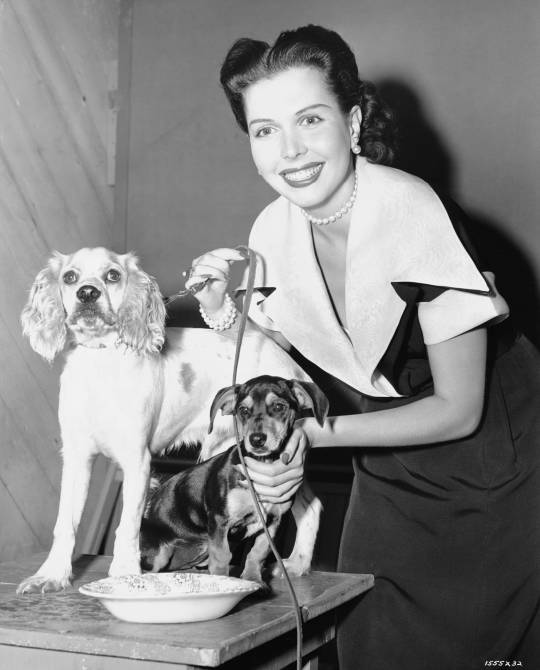
Big hair jokes aside, there really is something absolutely adorable about Miller that is hard to place your finger on. Beams of light still seemed to emanate from her face in her elder years. Not only was she the consummate professional, exuberant and entertaining with the mind of a steel trap, she was an essential keeper of the flame of all things Golden Age.
Her performances in KISS ME KATE (‘53), EASTER PARADE (‘48), LOVELY TO LOOK AT (‘52) and HIT THE DECK (‘55) were showstoppers, and those are only from her MGM years. Even her Stan Freberg directed Great American Soup commercial was one-minute and three-seconds of camp genius. If you are a musical fan and have not seen this commercial, stop reading now and look it up...don’t worry, I’ll wait. The way she rips her apron off to reveal her glittering costume as if she has been desperately awaiting this chance for her entire life, the overwhelming expression of sheer unadulterated rapture on her face, how she tosses her top hat with dynamic gusto, performing her signature twirls returning to the set of the kitchen— there is even a touch of Busby Berkeley for good measure. It simply could not be more gloriously MGM-musical perfect.
“It’s funny I never studied a lot of acting, I just thought acting was being me!”-Ann Miller
Usually, I have no issue detailing my favorite performances, however, with Miller I simply cannot. Each performance is consistently perfect and sure-footed with precise accuracy—it's almost impossible to choose one over another. Although she was not a Hollywood leading lady, she was showbiz through and through. Miller did, however, state in a 1990 interview with Bob Thomas, “Sugar Babies gave me the stardom that my soul kind of yearned for.'' If you watch her in interviews and her performances, you will find there is no line of delineation. Miller was a willing, fully assembled readymade pre-packaged star born for the spotlight. From her earliest performance to her last, one thing is resoundingly true—Ann Miller was not created for Tinseltown, Tinseltown was created for Ann Miller.
136 notes
·
View notes
Photo

South Pacific (1958)
With the 1955 movie adaptation of Richard Rodgers and Oscar Hammerstein II’s Oklahoma! proving to be a popular success a roadshow attraction, producers at the other Rodgers and Hammerstein Broadway musicals began laying the groundwork for cinematic versions. Oklahoma! was released by RKO, but the three R&H adaptations to follow were housed at 20th Century Fox. Within Fox’s domain, South Pacific followed Carousel (1956) and The King and I (1956). The stage musical South Pacific was based on a short story collection by James A. Michener entitled Tales of the South Pacific – the winner of the 1947 Pulitzer Prize for Fiction. In taking Michener’s work as inspiration, R&H implemented themes of racial prejudice that might have seemed groundbreaking upon the Broadway premiere in 1949 and the film’s late ‘50s release, but has become less norm-breaking in retrospect. Similar issues also affect The King and I. But when it comes to the theatrical releases, the craftwork and acting has assured The King and I’s place as one of the best Hollywood musicals. Shot on location in Hawai’i, South Pacific is an enormous production, but it contains less cinematic intrigue than other R&H adaptations.
Much of that is down to director Joshua Logan – experienced on the Broadway stage (the original runs for Annie Get Your Gun and Mister Roberts) not so much with movies (1955′s Picnic, 1956′s Bus Stop). Logan directed the original run for South Pacific for its five-year stay on the Great White Way. But the skillset for a successful stage director is not necessarily compatible with that of a film director’s. For example, when The Sound of Music first appeared on Broadway, it was not as universally acclaimed by audiences and theater critics. With its immortal 1965 adaptation under veteran film director Robert Wise, The Sound of Music surpassed its stagebound source material by embracing the Alpine scenery surrounding it, stretching images that makes possible what a Broadway audience might imagine.
Somewhere in South Pacific during World War II, the United States Navy and its Seabees are stationed, waiting for their next assignment. Aside from the usual tropical maladies, the most infectious affliction among the men is boredom. After an early song in which a local trader, Bloody Mary (Juanita Hall in yellowface; singing dubbed by Muriel Smith), describes the sexual mysteries of a nearby, forbidden island called Bali Ha’i, a few of the men find themselves aroused by the thought of easygoing dames. It is from here South Pacific establishes two storylines. The first centers around the love affair of Ensign Nellie Forbush (Mitzi Gaynor, the only major actor to do her own singing; her character is a nurse) and Emile de Becque (Rossano Brazzi; dubbed by Giorgio Tozzi) – a wealthy expat French planter with a guarded past – a past simultaneously hidden by time and in plain sight. The other subplot does not truly integrate itself until the second half, when Lieutenant Joseph Cable (John Kerr; dubbed by Bill Lee) visits Bali Ha’i and falls for Liat (France Nuyen).
Other significant characters include Luther Billis (Ray Walston), Captain George Brackett (Russ Brown), Commander Bill Harbison (Floyd Simmons), the Professor (Jack Mullaney), and Stewpot (Ken Clark; dubbed by the inimitable Thurl Ravenscroft). Elizabeth Taylor was considered by the producers for the role of Nellie, but, during her audition, she was so intimidated by Richard Rodgers that she could barely sing. It matters not, though, because Mitzi Gaynor’s performance is tremendous. Juanita Hall, as Bloody Mary, is the only original Broadway cast member to reprise her role.
Melodrama reigns. And melodrama, when paired with excellent filmmaking, can pack emotional wallops for even the steel-hearted viewers. Excellent filmmaking is not present here; far from it! The first appearance of major faults comes with Bloody Mary’s introduction, the song “Bali Ha’i”. Do not adjust the color configurations of whatever device you are reading this piece on – those saturated Technicolor filters blanketing the screen are present during many of the musical numbers and most dramatic scenes. During the film’s post-production, director Joshua Logan was concerned about how the rapid weather changes might appear in theaters. To mitigate that, Logan shot those aforementioned parts of the film through color filters – unintentionally mimicking the effects of mood lighting one might see on a stage play. Logan disliked the decision after seeing the final print, believing that the film processing lab saturated the colors to extremes. He requested reshoots but, because of South Pacific’s roadshow release schedule in which theater bookings were finalized months in advance, those never occurred. Logan reflected that the filters were the worst mistake of his filmmaking career, and I concur. Where these color tricks might work on stage, film is a different beast. As South Pacific is not a silent film, viewers do not expect tinting to that extent. Often occurring in the movie’s most romantic sequences, the oversaturation adds nothing to the poignancy onscreen. The filters are more suited for drinking games – not that I am giving you any suggestions.
Logan and cinematographer Leon Shamroy (1944′s Wilson, The King and I) botch the camerawork. The colorized filters interfering with the audience’s appreciation of the backgrounds, and this issue is exacerbated by Shamroy’s insistence on medium and medium-close shots for many of the musical numbers, as well as placing many props or foliage in the foreground. Shamroy sometimes carries over the same aesthetic and framing tendencies between musical numbers shot in the same general area (“There is Nothing Like a Dame” and “Bali Ha’i” in particular). The visuals, amid beautiful sights on Kaua’i, are frustratingly adequate given the on-location shooting.
As entertaining as South Pacific, it buckles with its gendered behaviors, questionable romance, and flawed arguments around racial relations. The secondary plot concerning Liat and Joseph Cable is grounded in the fears of Liat’s mother, Bloody Mary. With war raging across the Pacific and the fact that the economic presence of the U.S. Navy could disappear at a moment’s notice, Bloody Mary wants her child to enjoy the benefits of Western society and escape from the poverty of the islands. Liat, portrayed by Nuyen, has no agency and no choice of suitors because of her mother’s arrangements. Among their exotified neighbors, Liat, who does not speak a single word in this film adaptation (because apparently the worst sort of woman is someone who dares speak out concerning a man’s worst behaviors), embodies the Oriental feminine ideal pushed by artists over several hundred years: submissive, seductive, pale-skinned, giggling. Yet the musical and the film adaptation tends to play this for laughs, burying the narrative lede behind mother and daughter: the former preventing the latter from discovering love for herself, in the name of economic benefits (given how much money Bloody Mary claims she has made – and taking her at her word and inflation into account – their income probably far exceeds that of the average islander) and wartime expediency. Asian characters in Western narrative art – especially women – are often infantile, finding themselves at the mercy of underdeveloped, acquisition-hungry, and horny white characters. Where a musical like The King and I had its lead Asian and white protagonists on equal footing in terms of power and agency, that dynamic reverts to its stereotypical norm here. South Pacific has much to say about interracial romance – and not just with Liat and Cable – but its approach was and is regressive.
Not that the primary romance between Nellie and Emile is any better. From the moment they lay eyes on each other and an interested eyebrow is raised, Emile repeatedly engages in prevarication. He does this thinking that Nellie will not accept his truths – and really, too much of the drama in South Pacific occurs because of characters failing to explain their pasts or their reasoning (it’s tearing-hair-out-in-large-clumps stuff). Now, I’m all for forgiveness in leading one’s life. But Nellie, whose resentments are based on her personal racial intolerance and Emile’s history of obfuscation, forgives Emile too quickly, too easily to be believed. The two leads here are playing characters with an array of personal flaws that can be overcome. The resolution of those flaws plays out in the most dramatic fashion possible because, hey, it’s the Second World War and they have to put some war violence in there somehow!
It is my hope that you are watching South Pacific for its music, and not for the plot. Because the entire score from Rodgers and Hammerstein’s musical is intact, albeit many songs have been placed far differently from when they appear in the original stage musical. Credit to this film adaptation that the rearrangement of the song order makes greater sense here. Instead of jumping headfirst into Nellie and Emile’s romance, the film opts to introduce “Bloody Mary” and the Naval non-coms and Lieutenant Cable first with “There Is Nothing Like a Dame” – an enjoyable opening which establishes their longing for female company and restlessness. “Bali Ha’i” and the first appearance of the atrocious filters follows.
youtube
Soon after this the musical’s best works appear where in the stage version they were featured far too early. Nellie and Emile’s budding relationship is outlined by three songs following the other: “A Cock-Eyed Optimist” is followed by “Twin Soliloquies” and South Pacific’s signature song – “Some Enchanted Evening”. Also preserved in their spots from the stage musical are “I’m Gonna Wash That Man Right Outa My Hair” – the film unfortunately cuts two minutes from the song – and “I’m in Love with a Wonderful Guy”. The partial deletion of the former song speaks to how the filmmakers wanted to champion falling in love (as opposed to loving someone), but that does not make me adore the latter song any less. As an example of how poorly South Pacific treats its Asian characters, “Happy Talk” is featured in all of its glorious pidgin English embarrassment (the song is often cut in contemporary productions, including the 2001 television version). This is the only Rodgers and Hammerstein film adaptation in which all of the songs are intact – “My Girl Back Home” being the one addition (and it was cut from the original stage musical).
This review is based on the general release version which runs 157 minutes long and does not include the intermission. The roadshow version runs for 171 minutes; includes an overture, intermission, entr’acte, and exit music; and contains additional scenes. Both the general and roadshow versions are available on home media.
For South Pacific, various elements of this film version – from how it handles its two romantic subplots and its commentary on interracial romance and relations – have not aged gracefully. The Rodgers and Hammerstein score, even if this does not represent the height of their collective musical acumen, remains indelible. Forget the love declarations and probably one-sided relationships. Stay for the music.
My rating: 6/10
^ Based on my personal imdb rating. My interpretation of that ratings system can be found here.
#South Pacific#Joshua Logan#Rossano Brazzi#Mitzi Gaynor#Rodgers and Hammerstein#John Kerr#Ray Walston#Juanita Hall#Frane Nuyen#Russ Brown#Jack Mullaney#Ken Clark#Richard Rodgers#Oscar Hammerstein II#Leon Shamroy#TCM#My Movie Odyssey
2 notes
·
View notes
Text
Hattie McDaniel


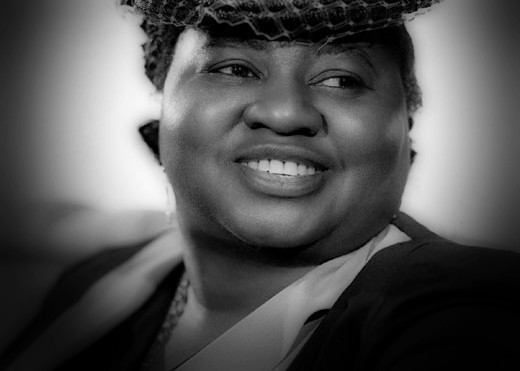



Hattie McDaniel (June 10, 1895 – October 26, 1952) was an African American actress, singer-songwriter, and comedian. She is best known for her role as Mammy inGone with the Wind (1939), for which she won the Academy Award for Best Supporting Actress, the first African American to win an Academy Award.
In addition to acting in many films, McDaniel was a professional singer-songwriter, comedian, stage actress, radio performer, and television star; she was the first black woman to sing on the radio in the U.S. She appeared in over 300 films, although she received screen credits for only 80 or so.
McDaniel has two stars on the Hollywood Walk of Fame in Hollywood: one at 6933 Hollywood Boulevard for her contributions to radio and one at 1719 Vine Street for acting in motion pictures. In 1975, she was inducted into the Black Filmmakers Hall of Fame and in 2006 became the first black Oscar winner honored with a US postage stamp.
Background and early acting career
McDaniel was born June 10, 1895, in Wichita, Kansas, to former slaves. She was the youngest of 13 children. Her father, Henry McDaniel, fought in the Civil War with the 122nd USCT and her mother, Susan Holbert, was a singer of religious music. In 1900, the family moved to Colorado, living first in Fort Collins and then in Denver, where Hattie graduated from Denver East High School. Her brother, Sam McDaniel (1886–1962), played the butler in the 1948 Three Stooges’ short film Heavenly Daze. Her sister Etta McDaniel was also an actor.
McDaniel was not only a performer but was also a songwriter. She honed her songwriting skills while working with her brother's minstrel show. After the death of her brother Otis in 1916, the troupe began to lose money, and Hattie did not get her next big break until 1920. From 1920 to 1925, she appeared with Professor George Morrison's Melody Hounds, a black touring ensemble. In the mid-1920s, she embarked on a radio career, singing with the Melody Hounds on station KOA in Denver. From 1926 to 1929, she recorded many of her songs for Okeh Records and Paramount Records in Chicago. McDaniel recorded seven sessions: one in the summer of 1926 on the rare Kansas City label Meritt; four sessions in Chicago for Okeh from late 1926 to late 1927 (of the ten sides recorded, only four were issued), and two sessions in Chicago for Paramount in March 1929.
After the stock market crashed in 1929, the only work McDaniel could find was as a washroom attendant and waitress at Club Madrid in Milwaukee. Despite the owner's reluctance to let her perform, she was eventually allowed to take the stage and soon became a regular performer.
In 1931, McDaniel moved to Los Angeles to join her brother Sam and her sisters Etta and Orlena. When she could not get film work, she took jobs as a maid or cook. Sam was working on a KNX radio program, The Optimistic Do-Nut Hour, and was able to get his sister a spot. She performed on radio as "Hi-Hat Hattie", a bossy maid who often "forgets her place". Her show became popular, but her salary was so low that she had to continue working as a maid.
Her first film appearance was in The Golden West (1932), in which she played a maid. Her second was in the highly successful Mae West film I'm No Angel (1933), in which she played one of the black maids with whom West camped it up backstage. She received several other uncredited film roles in the early 1930s, often singing in choruses.
In 1934, McDaniel joined the Screen Actors Guild. She began to attract attention and landed larger film roles, which began to win her screen credits. Fox Film Corporation put her under contract to appear in The Little Colonel (1935), with Shirley Temple, Bill "Bojangles" Robinson and Lionel Barrymore.
Judge Priest (1934), directed by John Ford and starring Will Rogers, was the first film in which she played a major role. She had a leading part in the film and demonstrated her singing talent, including a duet with Rogers. McDaniel and Rogers became friends during filming.
In 1935, McDaniel had prominent roles, as a slovenly maid in Alice Adams (RKO Pictures); a comic part as Jean Harlow's maid and traveling companion in China Seas (MGM) (McDaniels's first film with Clark Gable); and as the maid Isabella in Murder by Television, with Béla Lugosi. She appeared in the 1938 film Vivacious Lady, starring James Stewart and Ginger Rogers.
McDaniel had a featured role as Queenie in the 1936 film Show Boat (Universal Pictures), starring Allan Jones and Irene Dunne, in which she sang a verse of Can't Help Lovin' Dat Man with Dunne, Helen Morgan, Paul Robeson, and a black chorus. She and Robeson sang "I Still Suits Me", written for the film by Kern and Hammerstein.
After Show Boat, she had major roles in MGM's Saratoga (1937), starring Jean Harlow and Clark Gable; The Shopworn Angel (1938), with Margaret Sullavan; and The Mad Miss Manton (1938), starring Barbara Stanwyck and Henry Fonda. She had a minor role in the Carole Lombard–Frederic March film Nothing Sacred (1937), in which she played the wife of a shoeshine man (Troy Brown) masquerading as a sultan.
McDaniel was a friend of many of Hollywood's most popular stars, including Joan Crawford, Tallulah Bankhead, Bette Davis, Shirley Temple, Henry Fonda, Ronald Reagan, Olivia de Havilland, and Clark Gable. She starred with de Havilland and Gable in Gone with the Wind (1939).
Around this time, she began to be criticized by members of the black community for the roles she accepted and for pursuing roles aggressively rather than rock the Hollywood boat. For example, in The Little Colonel (1935), she played one of the black servants longing to return to the Old South, but her portrayal of Malena in RKO Pictures's Alice Adams angered white Southern audiences, because she stole several scenes from the film's white star, Katharine Hepburn. McDaniel ultimately became best known for playing a sassy and opinionated maid.
Gone with the Wind
The competition to play Mammy in Gone with the Wind had been almost as stiff as that for Scarlett O'Hara. Eleanor Roosevelt wrote to film producer David O. Selznick to ask that her own maid, Elizabeth McDuffie, be given the part. McDaniel did not think she would be chosen because she had earned her reputation as a comic actress. One source claims that Clark Gable recommended the role go to McDaniel; in any case, she went to her audition dressed in an authentic maid's uniform and won the part.
Upon hearing of the planned film adaptation, the NAACP fought hard to require the film's producer and director to delete racial epithets from it (in particular the offensive slur "nigger") and to alter scenes that might be incendiary and that, in their view, were historically inaccurate. Of particular concern was a scene from the novel in which black men attack Scarlett O'Hara, after which the Ku Klux Klan, with its long history of provoking terror on black communities, is presented as a savior. Throughout the South, black men were being lynched based upon false allegations they had harmed white women. That attack scene was altered, and some offensive language was modified, but another epithet, "darkie", remained in the film, and the film's message with respect to slavery remained essentially the same. Consistent with the book, the film's screenplay also referred to poor whites as "white trash", and it ascribed these words equally to characters black and white.
Loew's Grand Theater, on Peachtree Street in Atlanta, Georgia, was selected by the studio as the site for the premiere of Gone with the Wind, on Friday, December 15, 1939. Studio head David Selznick asked that McDaniel be permitted to attend, but MGM advised him not to, because of Georgia's segregation laws. Clark Gable threatened to boycott the Atlanta premiere unless McDaniel were allowed to attend, but McDaniel convinced him to attend anyway.
Most of Atlanta's 300,000 citizens crowded the route of the seven-mile motorcade that carried the film's other stars and executives from the airport to the Georgian Terrace Hotel, where they stayed. While Jim Crow laws kept McDaniel from the Atlanta premiere, she did attend the film's Hollywood debut on December 28, 1939. Upon Selznick's insistence, her picture was also featured prominently in the program.
For her performance as the house slave who repeatedly scolds her owner's daughter, Scarlett O'Hara (Vivien Leigh), and scoffs at Rhett Butler (Clark Gable), McDaniel won the 1939 Academy Award for Best Supporting Actress, the first black American to win an Oscar. She was the first black American to have been nominated. "I loved Mammy," McDaniel said when speaking to the white press about the character. "I think I understood her because my own grandmother worked on a plantation not unlike Tara." Her role in Gone with the Wind had alarmed some whites in the South; there were complaints that in the film she had been too "familiar" with her white owners. At least one writer pointed out that McDaniel's character does not significantly depart from Mammy's persona in Margaret Mitchell's novel, and that in both the film and the book, the much younger Scarlett speaks to Mammy in ways that would be deemed inappropriate for a Southern teenager of that era to speak to a much older white person, and that neither the book nor the film hints of the existence of Mammy's own children (dead or alive), her own family (dead or alive), a real name, or her desires to have anything other than a life at Tara, serving on a slave plantation. Moreover, while Mammy scolds the younger Scarlett, Mammy never crosses the more senior white woman in the household, Mrs. O'Hara. Some critics felt that McDaniel not only accepted the roles but also in her statements to the press acquiesced in Hollywood's stereotypes, providing fuel for critics of those who were fighting for black civil rights. Later, when McDaniel tried to take her "Mammy" character on a road show, black audiences did not prove receptive.
While many blacks were happy over McDaniel's personal victory, they also viewed it as bittersweet. They believed Gone With the Windcelebrated the slave system and condemned the forces that destroyed it. For them, the unique accolade McDaniel had won suggested that only those who did not protest Hollywood's systemic use of racial stereotypes could find work and success there.
1940 Academy Awards
The Twelfth Academy Awards took place at the Coconut Grove Restaurant of the Ambassador Hotel in Los Angeles. It was preceded by a banquet in the same room. Louella Parsons, an American gossip columnist, wrote about Oscar night, February 29, 1940:
Hattie McDaniel earned that gold Oscar by her fine performance of 'Mammy' in
Gone with the Wind
. If you had seen her face when she walked up to the platform and took the gold trophy, you would have had the choke in your voice that all of us had when Hattie, hair trimmed with gardenias, face alight, and dress up to the queen's taste, accepted the honor in one of the finest speeches ever given on the Academy floor.
McDaniel received a plaque-style Oscar, approximately 5 1/2 x 6 inches, the type awarded to all Best Supporting Actors and Actresses at that time. She and her escort were required to sit at a segregated table for two.
Gone with the Wind won ten Academy Awards, a record that stood for years. It was later named by the American Film Institute (AFI) as number four among the top 100 American films of all time.
Later career
In the 1942 Warner Bros. film In This Our Life, starring Bette Davis and directed by John Huston, McDaniel once again played a domestic, but one who confronts racial issues when her son, a law student, is wrongly accused of manslaughter.
The following year, McDaniel was in Warner Bros' Thank Your Lucky Stars, with Humphrey Bogart and Bette Davis. In its review of the film, Time wrote that McDaniel was comic relief in an otherwise "grim study," writing, "...Hattie McDaniel, whose bubbling, blaring good humor more than redeems the roaring bad taste of a Harlem number called Ice Cold Katie...."
McDaniel continued to play maids during the war years, in Warner Bros' The Male Animal (1942) and United Artists' Since You Went Away (1944), but her feistiness was toned down to reflect the era's somber news.
She also played the maid in Song of the South.
She made her last film appearances in Mickey (1948) and Family Honeymoon (1949). She remained active on radio and television in her final years, becoming the first black American to star in her own radio show with the comedy series Beulah. She also starred in the ABC television version of the show, replacing Ethel Waters after the first season. (Waters had apparently expressed concerns over stereotypes in the role.) Beulah was a hit, however, and earned McDaniel $2,000 a week. But the show was controversial. In 1951, the United States Army ceased broadcasting Beulah in Asia because troops complained that the show perpetuated negative stereotypes of black men as shiftless and lazy and interfered with the ability of black troops to perform their mission. After filming a handful of episodes, however, McDaniel learned she had breast cancer. By the spring of 1952, she was too ill to work and was replaced by Louise Beavers.
Legal case: Victory on "Sugar Hill"
McDaniel was the most famous of the black homeowners who helped to organize the black West Adams neighborhood residents who saved their homes. Loren Miller, an attorney and the owner and publisher of the California Eagle newspaper, represented the minority homeowners in their restrictive covenant case. In 1944, Miller won the case Fairchild v Rainers, a decision in favor of a black family in Pasadena, California, who had bought a nonrestricted lot but was sued by white neighbors anyway.
Time magazine, in its issue of December 17, 1945, reported that
Spacious, well-kept West Adams Heights still had the complacent look of the days when most of Los Angeles' aristocracy lived there....In 1938, Negroes, willing and able to pay $15,000 and up for Heights property, had begun moving into the old eclectic mansions. Many were movie folk — Actresses Louise Beavers, Hattie McDaniel, Ethel Waters, etc. They improved their holdings, kept their well-defined ways, quickly won more than tolerance from most of their white neighbors.But some whites, refusing to be comforted, had referred to the original racial restriction covenant that came with the development of West Adams Heights back in 1902 which restricted "Non-caucasians" from owning property. For seven years they had tried to enforce it, but failed. Then they went to court....Superior Judge Thurmond Clarke decided to visit the disputed ground—popularly known as "Sugar Hill." ... Next morning, ... Judge Clarke threw the case out of court. His reason: "It is time that members of the Negro race are accorded, without reservations or evasions, the full rights guaranteed them under the 14th Amendment to the Federal Constitution. Judges have been avoiding the real issue too long."Said Hattie McDaniel, of West Adams Heights: "Words cannot express my appreciation."
McDaniel had purchased her white, two-story, seventeen-room house in 1942. The house included a large living room, dining room, drawing room, den, butler's pantry, kitchen, service porch, library, four bedrooms and a basement. McDaniel had a yearly Hollywood party. Everyone knew that the king of Hollywood, Clark Gable, could always be found at McDaniel's parties.
Controversy over roles
As her fame grew, McDaniel faced growing criticism from some members of the black community. Groups such as the NAACP complained that Hollywood stereotypes not only restricted blacks to servant roles but often portrayed blacks as lazy, dim-witted, satisfied with lowly positions, or violent. In addition to addressing studios, they called upon actors, and especially leading black actors, to pressure studios to offer more substantive roles and at least not pander to stereotypes. They also argued that these portrayals were unfair as well as inaccurate and that, coupled with segregation and other forms of discrimination, such stereotypes were making it difficult for all blacks, not only actors, to overcome racism and succeed. Some attacked McDaniel for being an "Uncle Tom"—a person willing to advance personally by perpetuating racial stereotypes or being an agreeable agent of offensive racial restrictions. McDaniel characterized these challenges as class-based biases against domestics, a claim that white columnists seemed to accept. And she reportedly said, "Why should I complain about making $700 a week playing a maid? If I didn't, I'd be making $7 a week being one."
McDaniel may also have been criticized because, unlike many other black entertainers, she was not associated with civil rights protests and was largely absent from efforts to establish a commercial base for independent black films. She did not join the Negro Actors Guild of America until 1947, late in her career. McDaniel hired one of the few white agents who would represent black actors in those days, William Meiklejohn, to advance her career. Evidence suggests her avoidance of political controversy was deliberate. When columnist Hedda Hopper sent her Richard Nixon placards and asked McDaniel to distribute them, McDaniel declined, replying she had long ago decided to stay out of politics. "Beulah is everybody's friend," she said. Since she was earning a living honestly, she added, she should not be criticized for accepting such work as was offered. Her critics, especially Walter White of the NAACP, claimed that she and other actors who agreed to portray stereotypes were not a neutral force but rather willing agents of black oppression.
McDaniel and other black actresses and actors feared that their roles would evaporate if the NAACP and other Hollywood critics complained too loudly. She blamed these critics for hindering her career and sought the help of allies of doubtful reputation. After speaking with McDaniel, Hedda Hopper even claimed that McDaniel's career troubles were not the result of racism but had been caused by McDaniel's "own people".
Community service
During World War II, she served as chairman of the Negro Division of the Hollywood Victory Committee, providing entertainment for soldiers stationed at military bases. (The military was segregated, and black entertainers were not allowed to serve on white entertainment committees.) She elicited the help of a friend, the actor Leigh Whipper, and other black entertainers for her committee. She made numerous personal appearances at military hospitals, threw parties, and performed at United Service Organizations (USO) shows and war bond rallies to raise funds to support the war on behalf of the Victory Committee. (Bette Davis was the only white member of McDaniel's acting troupe to perform for black regiments; Lena Horne and Ethel Waters also participated. McDaniel was also a member of American Women's Voluntary Services.
She joined the actor Clarence Muse, one of the first black members of the Screen Actors Guild, in an NBC radio broadcast to raise funds for Red Cross relief programs for Americans that had been displaced by devastating floods, and she gained a reputation for generosity, lending money to friends and strangers alike.
Marriages
McDaniel married Howard Hickman in January 19, 1911, in Denver, Colorado. He died on March 7, 1915.
Her second husband, George Langford, died of a gunshot wound in January 1925, soon after she married him and while her career was on the rise.
She married James Lloyd Crawford, a real estate salesman, on March 21, 1941, in Tucson, Arizona. According to Donald Bogle, in his book Bright Boulevards, Bold Dreams, McDaniel happily confided to gossip columnist Hedda Hopper in 1945 that she was pregnant. McDaniel began buying baby clothes and set up a nursery in her house. Her plans were shattered when she suffered a false pregnancy and fell into a depression. She never had any children. She divorced Crawford in 1945, after four and a half years of marriage. Crawford had been jealous of her career success, she said, and once threatened to kill her.
She married Larry Williams, an interior decorator, on June 11, 1949, in Yuma, Arizona, but divorced him in 1950 after testifying that their five months together had been marred by "arguing and fussing." McDaniel broke down in tears when she testified that her husband tried to provoke dissension in the cast of her radio show and otherwise interfered with her work. "I haven't gotten over it yet," she said. "I got so I couldn't sleep. I couldn't concentrate on my lines."
Death
McDaniel died of breast cancer at age 57 on October 26, 1952, in the hospital on the grounds of the Motion Picture House in Woodland Hills, California. She was survived by her brother Sam McDaniel. Thousands of mourners turned out to celebrate her life and achievements. In her will, McDaniel wrote, "I desire a white casket and a white shroud; white gardenias in my hair and in my hands, together with a white gardenia blanket and a pillow of red roses. I also wish to be buried in the Hollywood Cemetery." The Hollywood Cemetery, on Santa Monica Boulevard in Hollywood, is the resting place of movie stars such as Douglas Fairbanks and Rudolph Valentino but refused to allow her to be buried there, because it, too, practiced racial segregation and would not accept for burial the bodies of black people. Her second choice was Angelus-Rosedale Cemetery, where she lies today.
In 1999, Tyler Cassidy, the new owner of the Hollywood Cemetery (renamed the Hollywood Forever Cemetery), offered to have McDaniel re-interred there. Her family did not wish to disturb her remains and declined the offer. Instead, Hollywood Forever Cemetery built a large cenotaph on the lawn overlooking its lake. It is one of Hollywood's most popular tourist attractions.
McDaniel's last will and testament of December 1951 awarded her Oscar to Howard University, where she had been honored by the students with a luncheon after she had won her Oscar. At the time of her death, McDaniel would have had few options. Very few white institutions in that day preserved black history. Historically, black colleges had been where such artifacts were placed. Despite evidence McDaniel had earned an excellent income as an actor, her final estate was less than $10,000. The IRS claimed the estate owed more than $11,000 in taxes. In the end, the probate court ordered all of her property, including her Oscar, sold to pay off creditors. Years later, the Oscar turned up where McDaniel wanted it to be: Howard University, where, according to reports, it was displayed in a glass case in the University's drama department.
Whereabouts of the McDaniel Oscar
The whereabouts of the McDaniel Oscar are currently unknown. In 1992, Jet magazine reported that Howard University could not find it and alleged that it had disappeared during protests in the 1960s. In 1998, Howard University stated that it could find no written record of the Oscar having arrived at Howard. In 2007, an article in the Huffington Post repeated rumors that the Oscar had been cast into the Potomac River by angry civil rights protesters in the 1960s. The assertion reappeared in the Huffington Post under the same byline in 2009.
In 2010, Mo'Nique, the winner of the Academy Award for Best Supporting Actress, wearing a blue dress and gardenias in her hair, as McDaniel had at the ceremony in 1940, in her acceptance speech thanked McDaniel "for enduring all that she had to so that I would not have to". Her speech revived interest in the whereabouts of McDaniel's plaque. In 2011, J. Freedom duLac reported in theWashington Post that the plaque had disappeared in the 1960s.
In November 2011, W. B. Carter, of the George Washington University Law School, published the results of her year-and-a-half-long investigation into the Oscar's fate. Carter rejected claims that students had stolen the Oscar (and thrown it in the Potomac River) as wild speculation or fabrication that traded on long-perpetuated stereotypes of blacks. She questioned the sourcing of the Huffington Post stories. Instead, she argued that the Oscar was likely returned to Howard University's Channing Pollack Theater Collection between the spring of 1971 and the summer of 1973 or had possibly been boxed and stored in the drama department at that time. The reason for its removal, she argued, was not civil rights unrest but rather efforts to make room for a new generation of black performers. If neither the Oscar nor any paper trail of its ultimate destiny can be found at Howard today, she suggested, inadequate storage or record-keeping in a time of financial constraints and national turbulence may be blamed. She also suggested that a new generation of caretakers may have failed to realize the historic significance of the 5 1/2" x 6" plaque.
Legacy and recognition
McDaniel has two stars on the Hollywood Walk of Fame in Hollywood: one at 6933 Hollywood Boulevard for her contributions to radio and one at 1719 Vine Street for motion pictures. In 1975, she was inducted posthumously into the Black Filmmakers Hall of Fame.
In 1994, the actress and singer Karla Burns launched her one-woman show Hi-Hat-Hattie (written by Larry Parr), about McDaniel's life. Burns went on to perform the role in several other cities through 2002, including Off-Broadway and the Long Beach Playhouse Studio Theatre in California.
Since 2007, the actress and singer Vickilyn Reynolds has been portraying McDaniel on stage in the musical "Hattie... What I Need You to Know." Reynolds not only wrote the play, but also composed ten of the twelve songs. The other two songs were composed by W.C. Handy ("St. Louis Blues") and Charlie Chaplin ("Smile"). She most recently performed the musical at UCLA's Schoenberg Hall on March 20–22, 2015 under the direction of Byron Nora. Hattie McDaniel's great-grandnephew, actor and producer Kevin John Goff, was in attendance for all the performances and gave a moving speech praising Reynolds performance. "Ms. Reynolds talent is without question," stated Goff as he addressed an astounded audience. "Hattie passed away before I was born and seeing Vickilyn perform was like meeting Hattie in person for the very first time. She is brilliant as Hattie and she was born to play my aunt on stage and in film."
In 2002, McDaniel's legacy was celebrated in American Movie Classics's (AMC) film Beyond Tara, The Extraordinary Life of Hattie McDaniel (2001), produced and directed by Madison D. Lacy and hosted by Whoopi Goldberg. This one-hour special depicted McDaniel's struggles and triumphs in the presence of rampant racism and brutal adversity. The film won the 2001–2002 Daytime Emmy Award, presented on May 17, 2002, for Outstanding Special Class Special.
McDaniel was the 29th inductee in the Black Heritage Series by the United States Postal Service. Her 39-cent stamp was released on January 29, 2006, featuring a 1941 photograph of McDaniel in the dress she wore to accept the Academy Award in 1940. The ceremony took place at the Margaret Herrick Library of the Academy of Motion Picture Arts and Sciences, where the Hattie McDaniel collection includes photographs of McDaniel and other family members as well as scripts and other documents.
The American rapper Nas pays tribute to McDaniel in his song "Blunt Ashes," from his eighth studio album, released December 15, 2006.
"Hattie McDaniel Day" was celebrated on August 16, 2011, by the national GLBT radio station OutQ (Sirius XM) on the Frank Decaro Show.
Kevin John Goff, McDaniel's great-grandnephew, is currently in pre-production on a three-part documentary on McDaniel's life. Part one will be completed in September 2015 and filmed in Los Angeles and Washington, D.C.
Wikipedia
9 notes
·
View notes